FILED: 3/24/2023 10:53 AM
Vermont Superior Court
Addison Unit
23-CV-01214
STATE OF VERMONT
SUPERIOR COURT
Addison Unit
Hon. James H. Douglas,
Special Administrator of the
Estate of John Abner Mead,
Plaintiff
Vs
The President and Fellows of
Middlebury College
Plaintiff

CIVIL DIVISION
Case No. 123456789
COMPLAINT
NOW COMES Plaintiff, Honorable James H. Douglas, Special Administrator of the Estate of John Abner Mead, by and through his attorneys of the firm Valsangiacomo, Detora & McQuesten, P.C., and hereby complains against Defendant, The President and Fellows of Middlebury College alleging the following facts and causes of action regarding:
The “Mead Memorial Chapel” at Middlebury College (1916-2021)
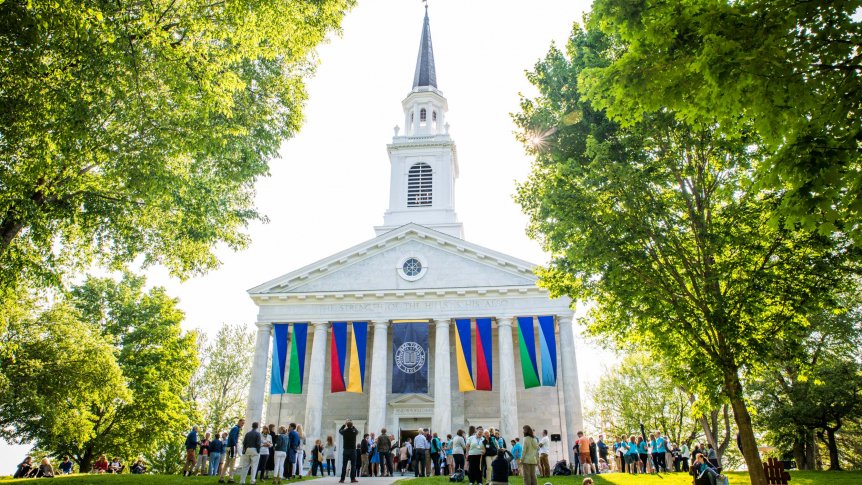
“A scapegoat remains effective as long as we believe in its guilt.” --Rene Girard
Table of Contents
I. Introduction ....................................................... 3
II. Parties and Venue ................................................. 9
III. Defendant Middlebury College .................................... 10
IV. Plaintiff’s Decedent John Abner Mead (1841-1920).................. 13
A. The Mead Family Ancestry ........................................ 13
B. John Mead’s Early Life and Education ............................ 13
C. Mead’s Civil War Service ........................................ 17
D. Mead’s Post-War Education ....................................... 19
E. Dr. Mead’s Medical Practice ..................................... 21
F. Mead the Businessman / Industrialist ............................ 25
G. Mead’s Government / Public Service .............................. 28
H. Mead’s Philanthropy ............................................. 31
I. John Abner Mead’s Death ......................................... 32
V. Mead Memorial Chapel ............................................... 13
A. The Mead Family Ancestry ........................................ 13
B. John Mead’s Early Life and Education ............................ 13
C. Mead’s Civil War Service ........................................ 17
D. Mead’s Post-War Education ....................................... 19
E. Dr. Mead’s Medical Practice ..................................... 21
F. Mead the Businessman / Industrialist ............................ 25
G. Mead’s Government / Public Service .............................. 28
H. Mead’s Philanthropy ............................................. 31
I. John Abner Mead’s Death ......................................... 32
VI. Causes of Action ................................................... 13
A. The Mead Family Ancestry ........................................ 13
B. John Mead’s Early Life and Education ............................ 13
C. Mead’s Civil War Service ........................................ 17
D. Mead’s Post-War Education ....................................... 19
E. Dr. Mead’s Medical Practice ..................................... 21
F. Mead the Businessman / Industrialist ............................ 25
G. Mead’s Government / Public Service .............................. 28
H. Mead’s Philanthropy ............................................. 31
I. John Abner Mead’s Death ......................................... 32
VII. Prayer for Relief ................................................. 13
I. Introduction
1. ln 1914, to commemorate the 50 th Anniversary of his graduation from Middlebury College, Dr. John Abner Mead, former Governor of Vermont, wrote to the President of his alma mater, Middlebury College, offering:
. . . to erect a chapel to serve as a place of worship for the college, the same to be known as the “Mead Memorial Chapel.” I have in mind a dignified and substantial structure, in harmony with the other buildings of the college, and expressive of the simplicity and strength of character for which the inhabitants of this valley and the State of Vermont have always been distinguished.
Ex. 1-001 (emphasis supplied).
2. Mead then told of his great-great-grandfather, James Mead, Rutland’s first settler, “who brought the first...Holy Bible into this unbroken wilderness,” and of his great-great-grandmother, Mercy Holmes Mead, who gathered the pioneers of the immediate area for the first Christian service in the Otter Creek Valley and shared fellowship with the local Native Americans. Mead’s Letter recounted their lives as embodying the simplicity, strength of character, and religious faith that Mead envisioned the Mead Memorial Chapel would symbolize:
. . . With this memory ever present, it has been my hope and prayer that I might be able and permitted to build for this college a suitable place for divine worship and that it might rise from the highest point on its campus as a symbol of the position, most prominent in every respect, which Christian character and religious faith should always maintain in its work for our youth.
Ex. 1-001 (emphasis supplied).
3. The Middlebury College Trustees unreservedly and enthusiastically accepted Dr. Mead’s offer, with the explicit understanding that the Chapel was to be known as the “Mead Memorial Chapel.”
4. Built of finely dressed Vermont marble and placed on the highest point on campus as Dr. Mead directed, the “Mead Memorial Chapel” stands not only as the most dominant building on the campus, but has become an iconic feature of Middlebury's landscape, serving as the flagship for the College’s identity, branding, marketing and merchandizing. Indeed, it is the face of Middlebury College for audiences to whom the College directs its promotional literature and videos:

Exhibit 5 – 009.

Exhibit 5 – 009.
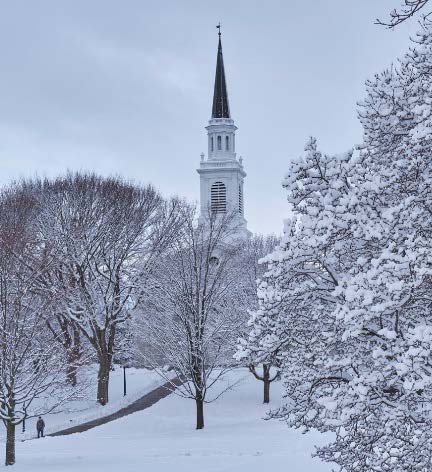
Exhibit 5 – 009.
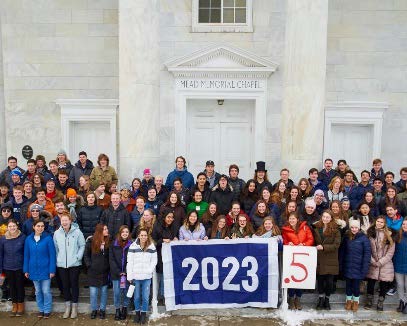
Exhibit 5 – 009.

Exhibit 5 – 009.
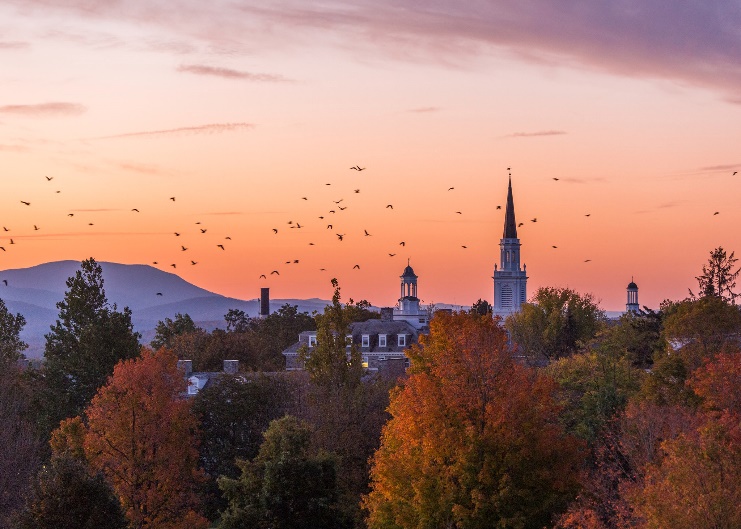
Exhibit 5 – 009.

Exhibit 5 – 009.
5. For more than a century, the Mead Memorial Chapel has been home to student performances, guest lectures, religious services, weddings, baptisms, funerals, and annual events like Convocation and Baccalaureate. Over the years, it has welcomed Academy Award winners, Nobel laureates, and pillars of art, business, and science for discussions, readings, and panels.
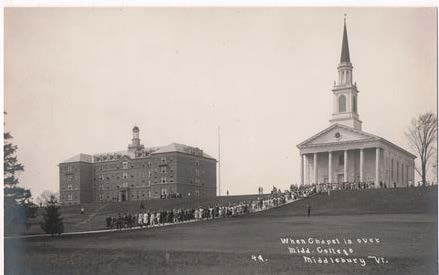
Ex. 5 – 008 - vintage postcard:
“When Chapel is Over”
Midd. College, Middlebury Vt."
6. Despite this storied past, in the early morning hours of Monday, Sept. 27, 2021, Middlebury College removed the wooden “Mead Memorial Chapel” sign, which hung unobtrusively in a niche above the entrance of the Chapel, identifying the College’s house of worship and “Meeting House” for community gatherings for the past 105 years.

Ex. 7 – 002.
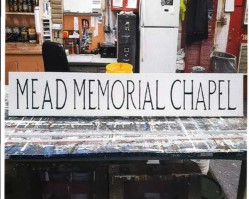
Ex. 7 – 003.
7. The College issued no warning that the name would be removed, held no public discussion, and offered no hint that such a dramatic change would occur. Instead, the College issued a statement only after the deed was done, announcing that the Mead Memorial Chapel would “no longer bear the name John Mead, Vermont governor from 1910 to 1912 and Middlebury Class of 1864, due to [Governor Mead’s] role in promoting eugenics policies in the state that led to the involuntary sterilization of an estimated 250 people.” This language makes a grossly distorted claim of the type that has become all too common in the current “cancel culture” in which we live. Such a claim is not what one would expect from an internationally renowned liberal arts college.
8. Nor is the erroneous claim that the College was removing “the name John Mead” from the Mead Memorial Chapel. The Chapel was not named for John Mead, nor was it built to honor or memorialize John Mead. Instead, it was erected by John Mead and named the “Mead Memorial Chapel,” in memory of the Mead family ancestors who embodied the values that were symbolized by the Chapel itself. It was with this understanding that the Trustees explicitly accepted a Chapel that would be known as the “Mead Memorial Chapel.”
9. In removing the Mead name from the Chapel, the College has not only breached that agreement and promise, but has obliterated any memory of the selfless acts and the altruistic contributions John Mead made to his nation, state, county, town, church, and to Middlebury College itself. In short, Middlebury College has “canceled” John Abner Mead, forever disparaged and vilified his family name, and replaced his legacy with a narrative that brands Governor Mead a eugenicist and proclaims him responsible for the tragic sterilization of Vermonters and Native peoples.
10. The unwarranted accusation conflates historical events that occurred two decades apart, declaring Mead responsible for legislation enacted 19 years after his Farewell Address and more than a decade after his death. Middlebury College’s stripping of “John Mead’s name” from the Mead Memorial Chapel makes Governor Mead a scapegoat and does a disservice to his memory, the good works he performed throughout his lifetime, and particularly the love and devotion he showed to Middlebury College.
11. The Mead Memorial Chapel was not a memorial to Governor John Abner Mead. Nor was the naming of the Mead Chapel some honor bestowed upon a big-money donor. Instead, Governor Mead built the Mead Memorial Chapel as a place for divine worship and a Meeting House for the Middlebury College Community.
12. He designed it to symbolize the simplicity and character of the people of the Otter Creek Valley and the State of Vermont and named it the “Mead Memorial Chapel” to memorialize the Mead family ancestors, who embodied that strength of character and who brought Christian faith, fellowship, and community to early Vermont.
13. The basis for the furtive removal of Mead’s name was the Governor’s support, in his Farewell Address of 1912, for proposals to restrict the issuance of marriage licenses and to appoint a commission to study the use of a new operation called a vasectomy, which was a safer and more humane process of sterilization. However, the claim that Mead’s 1912 comments caused sterilizations to happen two or three decades later is factually baseless and legally unjust.
14. Middlebury College has proclaimed that Governor Mead was a eugenicist and has implied, without evidence, that racism motivated his proposals. These charges are without merit and they belie everything we know about Mead’s life, the medical, military, and public services he performed, as well as his generous philanthropy to his college, church, and the broader community.
15. This “culture cancellation” and the College’s erasure of Governor Mead’s good deeds and lifelong contributions contradict the very purpose of the College. A higher education institution exists to pursue truth and knowledge, not to erase history.
16. More importantly, Middlebury College has violated the sacred trust that Dr. Mead placed in the Trustees of his beloved alma mater, breaking the promises they made and depriving him and his family of the benefit of his bargain, the quid pro quo, and/or the conditions of his gift: that Mead would erect a chapel to be known forever as the “Mead Memorial Chapel.”
II. Parties and Venue
17. On June 17, 2022, the Vermont Superior Court, Rutland Unit, Probate Division, in the matter of the Estate of John Mead, Case No. 22-PR- 02895, appointed the Honorable James H. Douglas as Special Administrator of the Estate of John Abner Mead, granting him full authority to represent the Estate in this litigation.
18. Plaintiff, the Honorable James H. Douglas, Special Administrator of the Estate of John Abner Mead, is a resident of the Town of Middlebury, County of Addison and State of Vermont.
19. Defendant, The President and Fellows of Middlebury College is a Vermont Non-profit Corporation chartered on November 1, 1800 and doing business as Middlebury College, with its principal place of business in the Town of Middlebury, County of Addison and State of Vermont.
20. The President and Fellows of Middlebury College, more familiarly known as the Board of Trustees, holds ultimate legal and fiduciary responsibility for all assets and operations of Middlebury College.
21. Venue is proper pursuant to 12 V.S.A. §402(a).
III. Defendant Middlebury College
22. Middlebury is a liberal arts college of the first rank, an achievement that is the result of a process of growth and change that began in 1800, when a few men of the town of Middlebury took upon themselves the challenge of building a college in a small New England town, on what was then the American frontier.
23. Over the more than two centuries since it was established, Middlebury has developed from “the town’s college” into an institution of international renown with a $1.518 billion endowment as of 2021.
24. Middlebury’s original purpose was to train young men from Vermont and neighboring states for the ministry and other learned professions of the early 19th century. The College began modestly, with seven students enrolling in November 1800. These first students were expected “to read, translate, and parse Tully, Virgil, and the Greek Testament, and to write true Latin in prose, and shall have also learned the rules of Vulgar Arithmetic.” The College’s founding president, Jeremiah Atwater, who had come to Middlebury from Yale, taught the entire course of study.
25. Gamaliel Painter, one of the citizens of Middlebury to whom the College charter had been granted, left most of his estate to the College. Mr. Painter’s gift was an early example of the philanthropic support for Middlebury College that has enabled the institution to prosper. In recognition of his gift, West College, a new building completed a few years prior to Painter’s death in 1819, was renamed Painter Hall. Painter Hall is the oldest college building extant in Vermont.
26. Vermont was one of the first colonies to ban slavery and the first state to abolish slavery in its constitution. In 1823, Alexander Twilight graduated from Middlebury, the first African American citizen to earn a baccalaureate degree at an American college.
27. Middlebury College continued to grow during the 19th century. The growth was sporadic, however, as the College was not immune to the social and political movements that were affecting northern New England generally. Rocked by evangelical upheaval and religious revival in the 1830s and the Civil War in the 1860s, Middlebury managed to keep its doors open during a period when many small colleges in America were forced to close. In large part, the College survived because of the support of its many friends, both in the town of Middlebury and in the surrounding region.
28. In 1883, the Trustees voted to accept women as students in the College, making Middlebury one of the first formerly all-male liberal arts colleges in New England to become coeducational. In the following years, Middlebury College began to change from an institution primarily oriented toward its community and its state to a college with larger regional aspirations. President Ezra Brainerd (who held that office from 1885 to 1908) prepared the College for this transformation, and spectacular change occurred under the administration of President John Thomas (1908 to 1921), who established the Language Schools and the Bread Loaf School of English during his presidency.
29. During the second decade of the 20th century, the College’s enrollment more than doubled, and the number of buildings, the size of the faculty, and the value of the endowment tripled. At the same time, the College adapted its curriculum to the needs of the new century.
30. During the 1930s, 1940s, and 1950s, Middlebury continued its development toward a position of prominence among liberal arts colleges in the United States. Continued growth in the faculty meant the addition of new subjects to the curriculum and an enhanced academic reputation for the College. New residence halls, academic buildings, and library facilities were added to the physical plant. Middlebury’s expansion was coupled with increases in financial resources and the establishment of a tradition of prudent financial administration, including the cultivation of resources for the long term.
IV. Plaintiff’s Decedent John Abner Mead
31. John Abner Mead (April 20, 1841 – January 12, 1920) was a Vermont physician, businessman, politician, and philanthropist who served as Vermont’s 47th Lieutenant Governor from 1908 to 1910, and Vermont’s 53rd Governor from 1910 to 1912.
32. Mead was a graduate of Middlebury College, Class of 1864. In 1914, on the 50 th anniversary of his graduation, he offered to erect the “Mead Memorial Chapel,” an offer the Trustees of the College eagerly and unequivocally accepted.
A. The Mead Family Ancestry
33. John Abner Mead was of English descent, with notable ancestry. Westminster Abbey houses a memorial to one of his ancestors, Richard Mead, M.D. (1673-1754) who was one of the leading physicians of his day, an expert on poisons, scurvy, smallpox and public health. Dr. Richard Mead attended Queen Anne, was physician to King George II, and treated Sir Isaac Newton and the French painter Antoine Watteau as patients. His work, A Short Discourse concerning Pestilential Contagion, and the Method to be used to prevent it (1720), was of historic importance in the understanding of transmissible diseases:
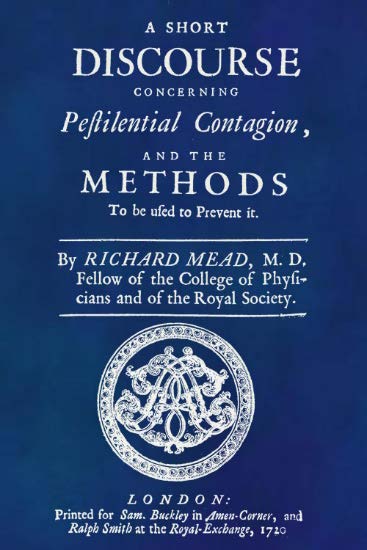
Ex. 8–038 to 053.
34. Another ancestor, Colonel Richard K. Mead was aide-de-camp to General Washington from 1777 to 1783 and was with the commander-in-chief in all his principal battles. The Right Reverend William Mead, Bishop of Virginia, was of the same family.
35. John Abner Mead’s great-great-grandfather, Colonel James Mead (1730-1804), was a notable pioneer and Rutland’s first settler. He and his wife, Mercy Holmes Mead, were the parents of the first child of European descent born in the Otter Creek Valley. He served as the first Moderator and first Selectman of the Town of Rutland and first Representative from Rutland to the first Vermont Legislature. He was a distinguished patriot of his day, serving as a Colonel of the 3rd Regiment of Vermont Militia during the Revolutionary War.
36. Colonel James Mead’s historic contributions are memorialized by the Vermont Division for Historic Preservation’s Historic Marker at Mead’s Falls and in an 1848 landscape painting of Mead’s Falls by Fredric Edwin Church, which hangs in the White House:
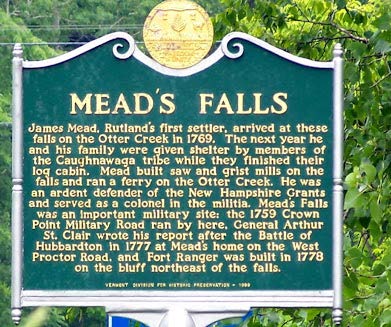
Ex. 8-009 - VT Div Historic Preservation Marker Mead’s Falls
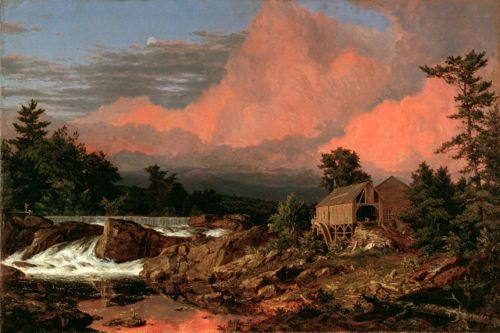
Ex. 8-010 - “Rutland (Mead’s) Falls” (1848) By Fredric Edwin Church
B. John Mead’s Early Life and Education
37. John Abner Mead’s father, Rowley R. Mead (1818–1875), was born in West Rutland. In 1839, at age 21, Rowley Mead moved to Fair Haven and settled on a small farm there, marrying Lydia Ann Gorham (1818-1841).
38. John Abner Mead was born on April 20, 1841. His mother, Lydia Ann Gorham Mead, went into a decline soon after giving birth and died weeks later, on August 11, 1841, aged 23.
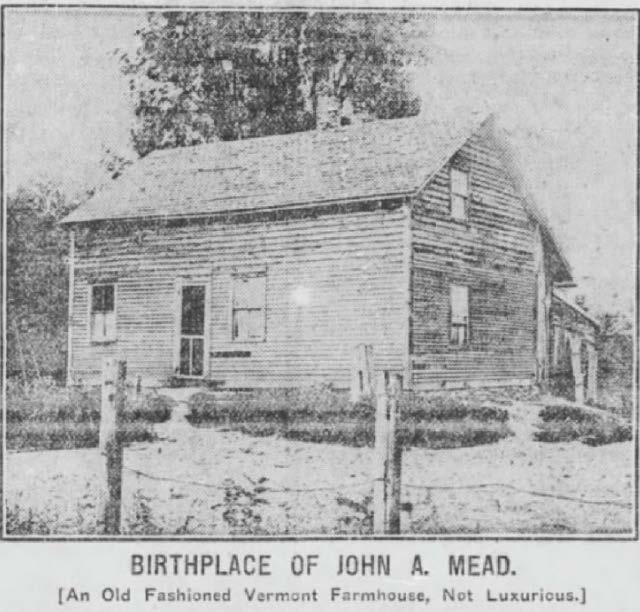
Ex. 8-014.
39. After Lydia’s death, the infant son was left with a family in Fair Haven to be cared for, remaining with them for several years. Rowley Mead married again and had two other children, but John was virtually given to an aunt, Mrs. Blanchard, who cared for him during childhood. He lived with her much of the time until he was sixteen years old.
40. Young Mead attended the common schools at West Rutland, working odd jobs to earn money for his future education, which his father was too poor to support. In the years of 1857 and 1858, John Mead worked as a teacher at a district school, for which he received $15 per month and “boarded around,” as the custom was. When he received the $45 for the final three months’ service, he had accumulated $425. With this he started in life.
41. In Spring of 1858, at age 17, Mead wrote to his uncle, who lived in Malone, NY and who was the principal of what was then known as Franklin Academy. The uncle allowed John to attend school there and do “chores” about the house for his board and about the schoolhouse for tuition and books.
42. There Mead prepared himself for Middlebury College. He was accepted and, with his original $425, he was admitted in the fall of 1860.
C. Mead’s Civil War Service
43. Interrupting his studies at Middlebury College to answer President Abraham Lincoln’s call to arms, John Mead enlisted during the American Civil War in Company K, Twelfth Infantry Regiment, Vermont Volunteers, serving from 1862-1863. He participated in several skirmishes and important battles, including the Battle of Gettysburg, the bloodiest battle in American history, with more than 50,000 estimated casualties.
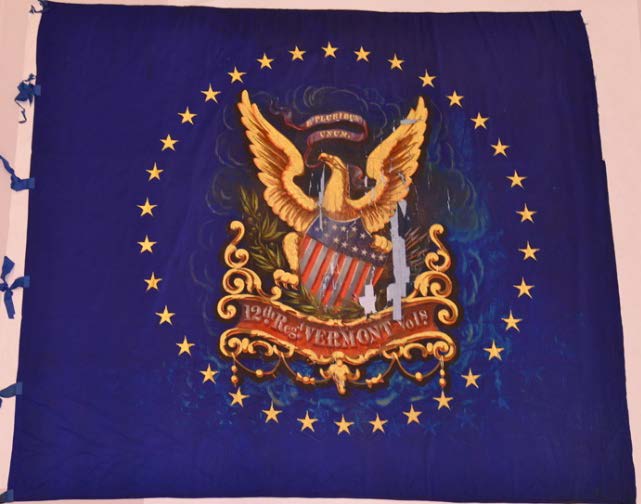
Ex. 8-005 - 12th Regiment Vermont Volunteers Flag
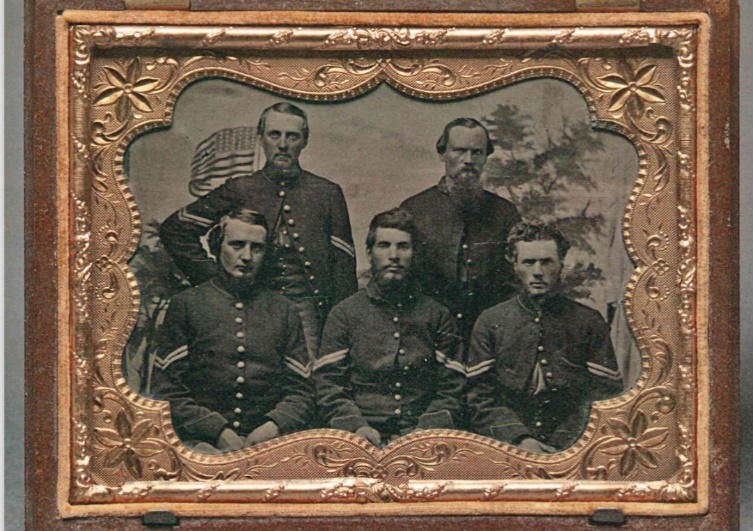
Ex. 8-005 - Middlebury College Vermont Volunteers. Mead is back row on left.
44. John Mead’s Company K rifle has been passed down through the generations of the Mead family, the original full bayonet testifying to the brutal and primitive nature of the conflict:


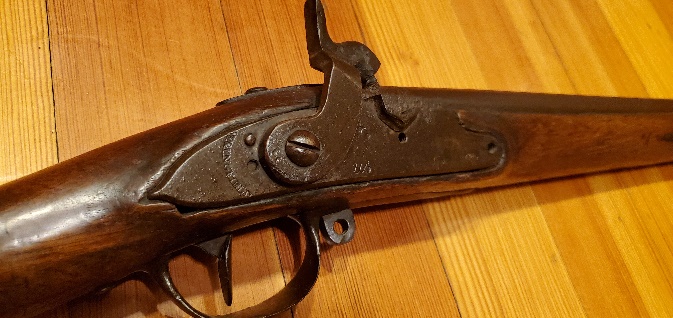
Ex. 8-001.
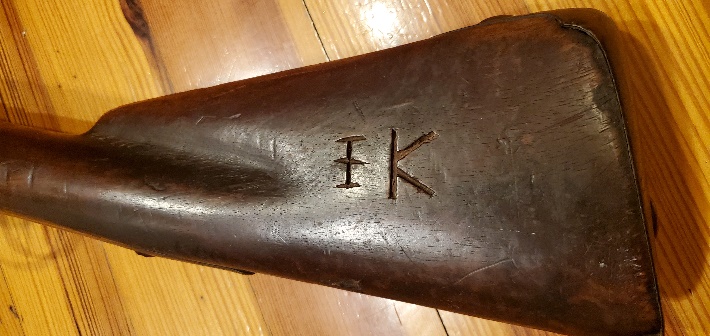
Ex. 8-002.
45. Several other members of the Mead family contributed significantly to the war effort and to post-war Rutland and Vermont. All were descendants of James Mead, the first settler of Rutland. Brothers Charles and Carlos (Eugene) Mead, cousins to John A. Mead, also joined the Union Army, serving in the First U. S. Sharpshooters Regiment. Charles was killed at Petersburg, Virginia; Eugene was wounded twice and imprisoned once. Charles Mead was a prolific writer. His letters and diaries are a major source of information to Rutland Civil War historians.
46. Therefore, when the College Trustees removed the Mead family name from the Mead Memorial Chapel, they demeaned the sacrifices of not one, but three Civil War veterans who fought to free the African American slaves in the South and preserve the Union. One member made the ultimate sacrifice, and another was wounded twice and imprisoned.
D. Mead’s Post-War Education
47. After Gettysburg, Mead returned to Middlebury College to complete his studies so he could graduate with his class in 1864. He studied hard to make up for lost time in school while working at haying in the summer and teaching school in the winter to support himself. Upon graduation he had to sell all his books, so he graduated from Middlebury College solvent but nearly penniless.
48. John Mead was chosen as a speaker for his 1864 Commencement ceremony and delivered a speech entitled “The Moral Effects of the War,” having witnessed the horrors of Gettysburg just one year prior.
49. John Abner Mead’s Middlebury College Class Photo:
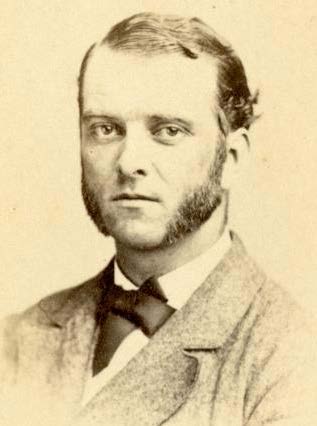
Ex. 8-006. John Abner Mead’s Middlebury College Class Photo
50. After graduation from Middlebury, Mead continued to teach high school for a term and then began to study medicine with Professor Joseph Perkins, M.D. of Castleton, paying most of his expenses by caring for the office and assisting the doctor.
51. Mead took a 10-month hiatus from his medical education to toil in the West Rutland quarries, enabling him to save enough money to complete his medical training.
52. Mead then returned to the study of medicine, attending the first course of lectures in the medical department of the University of Vermont, studying under his now Preceptor Joseph Perkins, M.D., Professor of Obstetrics and Diseases of Women and Children. Mead wrote his thesis on “Inversio-Uteri”, a childbirth complication often resulting in death at that time, which perhaps was his own mother’s cause of death shortly after his birth. Upon completing his studies and thesis at UVM, he was awarded a Master’s Degree (A.M.) at Middlebury College in 1867.
53. Mead then went to New York to complete his medical degree at the College of Physicians and Surgeons of New York City, part of Columbia University, graduating with an M.D. degree in 1868.
E. Dr. Mead’s Medical Practice
54. While working towards his medical degree in New York, Mead worked at Kings County Hospital’s Lunatic Asylum in Brooklyn as a Second Assistant Physician. Upon graduation, he was promoted to First Assistant Physician and a year later, he was made the Assistant Physician of the Lunatic Asylum. Notably, the Asylum did not use physical restraints for patients, allowing them instead to freely mingle and take exercise at their leisure.
55. During Dr. Mead’s tenure as resident physician, he demonstrated great compassion for his patients. “He did not treat them as though he thought them insane. He held that it always irritated a man, sane or insane, to be told that he was mentally deranged. He listened patiently to their complaints and even humored their whims. I will not say that he believed in ‘mind cure’, for the phrase has acquired unfortunate associations. But he believed that a wise physician should always have a thought for the mental condition of his patients and in all his later medical practice he was guided by this rule.” Ex. 8-034 to 8- 035.
56. The Mead family still possesses Dr. Mead’s Kings County Hospital Alumni Association medal:
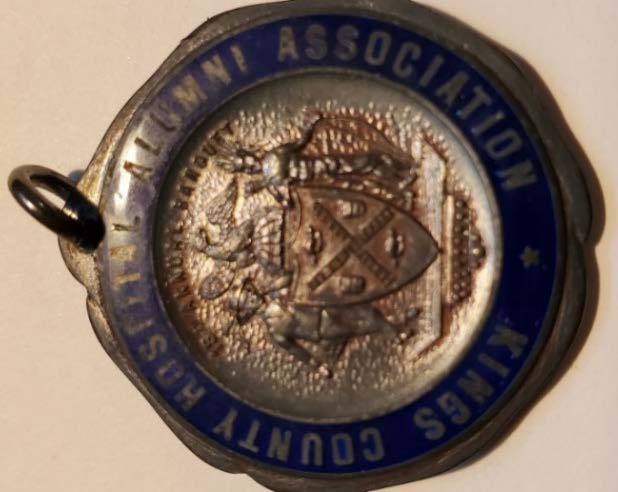
Ex. 8-001.
57. In the fall of 1870, Dr. Mead resigned his position in the Kings County Hospital’s Lunatic Asylum and returned to Vermont to practice medicine in Rutland for the next two decades.
58. Dr. Mead began his medical practice in Rutland in a small way with a single room and had only money enough to buy a horse and office furnishings, including a cloth lounge, on which he slept for almost two years.
59. This is a Business Card advertisement that Dr. Mead ran in the January 18, 1871 Rutland Daily Herald:
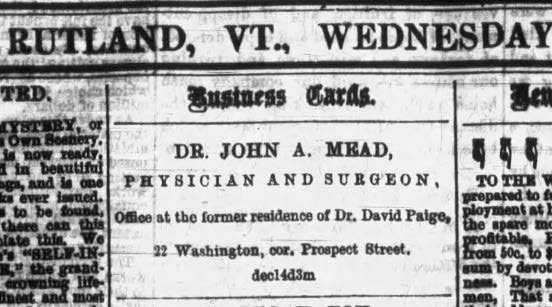
Ex. 8-011.
60. On October 30, 1872, John Mead married Mary M. Sherman. They had one child, Mary Sherman Mead Hinsman.
61. While practicing medicine in Rutland, Dr. Mead also served as the State of Vermont’s Surgeon General under Governor Redfield Proctor from 1878 to 1880 and was a member of the staff of General Alger and General Veazey, commanders of the Grand Army of the Republic, a fraternal organization of veterans who had served in the Union Army during the Civil War.
62. Dr. Mead was also Medical Superintendent of the Vermont House of Correction and served as State Pension Examiner for eight years.
63. In 1888, Dr. Mead was offered a "Chair" in the Medical Department of the University of Vermont but declined it because he wished to retire from medicine and devote his time to his business interests.
64. In 1890, Dr. Mead was appointed Surgeon General of the Vermont State Encampment of the Grand Army of the Republic.
65. This photograph of Company K shows Civil War Veterans gathered at the Bennington Encampment the following year, in 1891, for their 30th reunion at the dedication of the Bennington Battle Monument Memorial which was attended by President Benjamin Harrison and thousands of spectators.
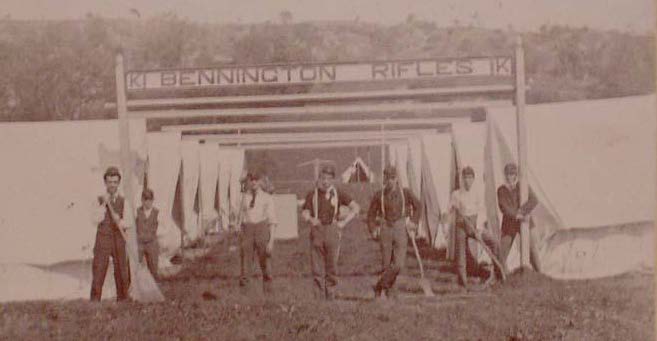
Ex. 8-007.
66. The Mead family possesses some of John Abner Mead’s Grand Army of the Republic (“GAR”) memorabilia:
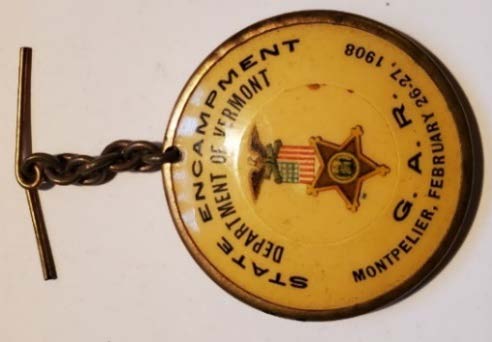
Ex. 8-002.

Ex. 8-002.
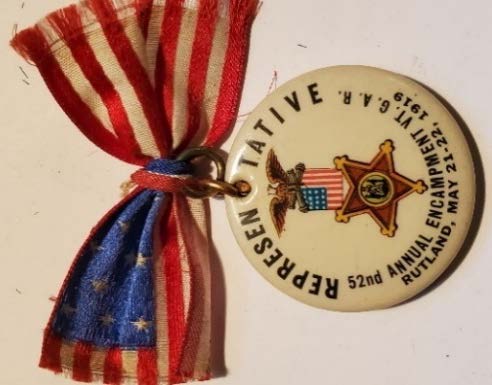
Ex. 8-002.
F. Mead the Businessman/Industrialist
67. After retiring from the practice of medicine, Mead became a successful real estate investor, buying the Bates House block in 1880, which was the largest transfer of real estate that had ever taken place in the Town of Rutland up to that time.
68. This is a photo of the Mead Building in Rutland, cir. 1910:
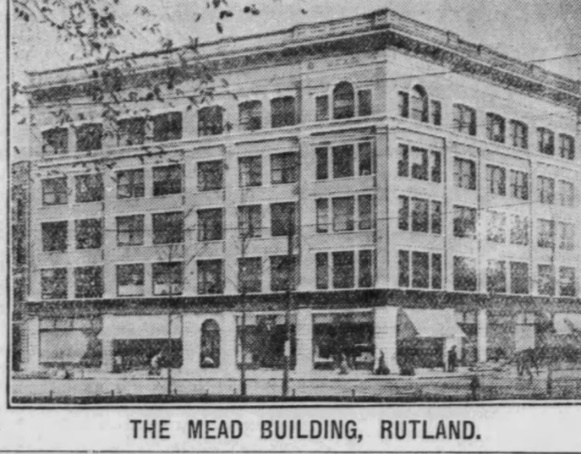
Ex. 8-014.
69. From 1882 to 1888, Mead served as an executive or director of several enterprises, including banks, railroads, insurance, and manufacturing companies.
70. In 1888, he became president of and reorganized the Howe Scale Company, a corporation that had gone through bankruptcy three times. Much to Mead’s credit, the company became one of the most important and successful enterprises in New England and manufacturers of a scale recognized as the standard the world over.
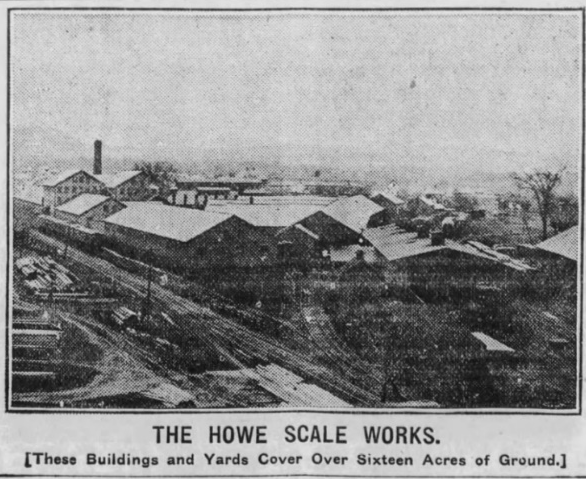
Ex. 8-014.
71. Dr. Mead exhibited rare executive ability. His watchful care of every detail and his keen judgment of human nature enabled him to select competent assistants in the varied departments. These skills, along with his perseverance, were largely responsible for the remarkable success of this industry, which created prosperity for many Vermont families.
72. In addition to his other business endeavors, Dr. Mead purchased the Hayward farm in West Rutland which he renamed the “Otter Creek Stock Farm,” an estate of about 500 acres supporting 125 head of cattle and producing 300 tons of hay as well as three large silos of ensilage grown on one of the largest fields of ensilage corn in the state, reported to be “50 acres in extent and growing as level and perfect as it is possible to imagine.” Ex. 8-014.
73. Mead’s Otter Creek Stock Farm provided employment opportunities for local farm workers and was a model of its kind, having running water supplied from a spring on the hillside for all purposes, including fire protection.

Ex. 8-014 - Mead’s Otter Creek Stock Farm
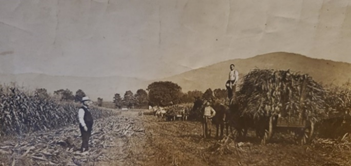
Ex. 8-003 - Photo of John Mead on his West Rutland farm.
74. Mead “has always shown a kindly interest in the welfare of his employees and of the workingmen, and has never hesitated to champion their cause whenever their demands were reasonable and in his judgement just, and they in turn evinced their appreciation of his efforts in electing him to the state Senate in 1892 by a large majority, and again in 1893 by making him the first mayor of the city of Rutland by over three-fourths of the total vote cast for the candidates for this office.” Ex. 8-014.
G. Mead’s Government and Public Service
75. In 1892, Mead was elected to the State Senate as the GOP nominee and took an active part in the workings of that body, serving as chairman of several important committees. One of the beneficial results of his term in that capacity was the securing of a city charter for Rutland, and in 1893, Dr. Mead was elected its first mayor, “devoting to municipal interests that same sound judgment and careful attention to matters great or small which he gave to his own business.”
76. A photo of John Abner Mead, Cir. 1890s:
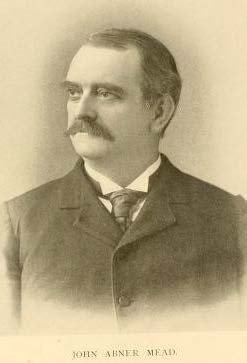
Ex. 8-006
77. John Abner Mead served as Vermont’s Lieutenant Governor from 1908 to 1910. The June 18, 1908 edition of the Rutland Weekly Herald reported:
"Dr. Mead is a worthy citizen of Vermont. He is public spirited, active in good works, and a promoter of the interests of the state, morally, materially and religiously. He has always cheerfully borne his share of the public duties in state, county, city, church and school - in all of which he has long been active. He is as democratic a citizen and as genial a comrade as anyone should wish to know.
...Dr. Mead conducts one of the great industries of the state; and has managed it successfully, to the advantage of the state, if also to his own profit. His passage from poverty to competency has been most honorable.”
Ex. 8-012.
78. Elected Governor of Vermont in 1910, Mead presided over the state legislature’s reapportionment of state senatorial districts. Legislation was enacted during his administration establishing Vermont Technical College, requiring the registration of nurses, and providing for a direct primary.
79. Mead was viewed as a progressive. He supported women’s suffrage, toughened child labor laws, and strengthened campaign finance statutes. He doubled funding for highways and favored clean energy, urging the substitution of hydroelectric power for coal.
80. Dr. Mead was a Trustee of Middlebury College, UVM, and Norwich University. All three conferred the honorary degree of LL.D. upon him in 1911.
81. Governor Mead gave his Gubernatorial Farewell Address to the Joint General Assembly in October 1912. Ex. 18-017 to 18-031.
82. Mead was also a Vermont delegate to the Republican National Convention in 1912, supporting the incumbent Taft for the nomination:
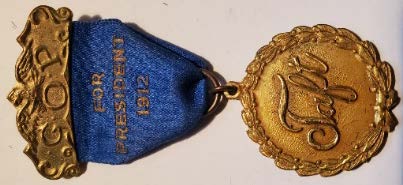
Ex. 8-002

Ex. 8-002
83. Mead was seriously considered for the vice-presidential nomination on the national ticket in 1912 because of his progressive views. The Mead family inherited the campaign memorabilia from the possible run:

Ex. 8-002
84. After his governorship, Mead resumed his business interests. He was president of Baxter National Bank, Howe Scale Company, and of John A. Mead Manufacturing Company. He was also a director of the Rutland Railroad.
H. Mead’s Philanthropy
85. John Abner Mead made substantial financial donations to Middlebury College during his lifetime, including his conditional gift of the “Mead Memorial Chapel” which he constructed from 1914 to 1916 at a cost of over $75,000.
86. In addition, Dr. Mead made substantial financial donations to other charitable causes during his lifetime, including in 1915, when he donated prime Rutland real estate located at the corner of Center and Court Streets to the Congregational Church of Rutland to be used by the young people of Rutland, of all faiths, as a community center with club rooms, gymnasium, tennis courts, etc. The center became known as “The Community House”:
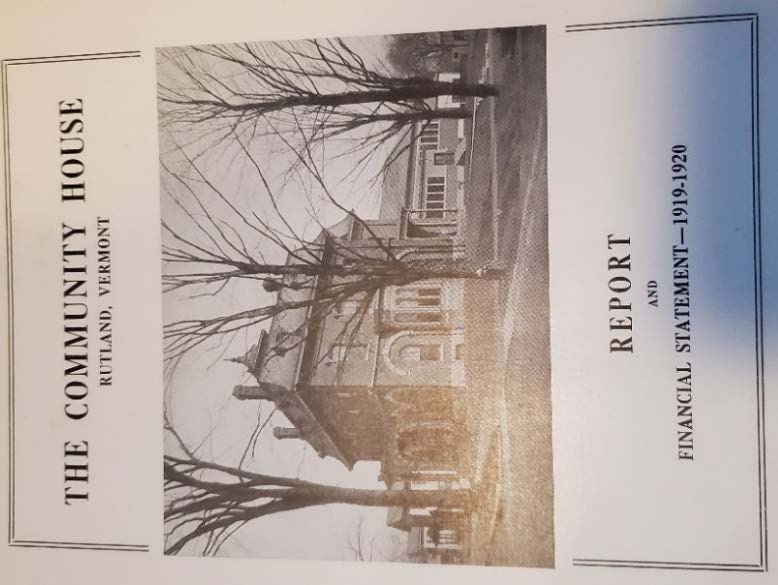
Ex. 8-004
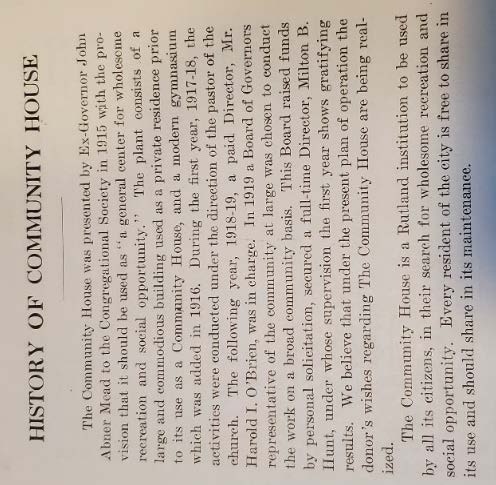
Ex. 8-004
87. Mead invested some $50,000 (worth $1,469,292.08 in current value) in 1915 to transform the property into an inclusive and welcoming community center for all the youth of Rutland “regardless of creed or church connection to make it of the widest scope.” The real estate and improved buildings were deeded to the Congregational Church of Rutland, with the direct management of a nonsectarian board with liberal powers.
88. Mead’s Last Will and Testament bequeathed an additional $50,000 to provide for the continued maintenance and support of The Community House after his death.
89. Mead’s Last Will and Testament also bequeathed $50,000 to the Congregational Church of Rutland for the maintenance of other Congregational churches in Rutland County.
I. John Abner Mead’s Death
90. Dr. John Abner Mead died of pneumonia at his home in Rutland on January 12, 1920. He was 78 years old. His wife, daughter, grandson, and son- in-law survived him.
91. Middlebury College President Thomas eulogized Governor Mead at his funeral, describing his good friend :
“By his keenness of mind, his fixity of purpose, his unfailing judgment, his insatiable ambition, and his unconquerable will Dr. Mead ranged himself with those great creative spirits who have wrought the prosperity and wealth of this nation and accomplished the civilization of the modern world.”
“He was no ordinary man and judgment upon him must be guided by no ordinary standards. He was one appointed of Providence a master builder in the industry of his generation, whose ambition and ability were made to serve the welfare of this city and the prosperity of our fair State beyond the measure of almost any other of his time, he did it almost alone.”
“He was one of the most democratic and approachable of men. I have often thought that his extreme simplicity and cordiality in public relations blinded the eyes of those who saw him every day to some of his most remarkable qualities, Governor Mead was a very keen and shrewd observer and a man who preserved at all times independent and original judgement.”
Ex. 8-034 to 8-035.
92. John Mead was buried at the Mead Family plot in Evergreen Cemetery in Rutland with his ancestors, including Colonel James Mead and Mercy Holmes Mead, whom John Abner Mead had reinterred there from the West Rutland Cemetery in 1895.
93. John Abner Mead’s headstone records his service in the Union Army, his professional life as “a beloved physician in Rutland for 21 years,” and his many offices held including his Governorship of course. His headstone reflects the essence of who he was and his lifetime of service and devotion to others with the final engraving:
“A CHRISTIAN
AND
PHILANTHROPIST”
Ex. 8-008.
94. Photos of the Mead Family Plot in Evergreen Cemetery in Rutland, Vermont:
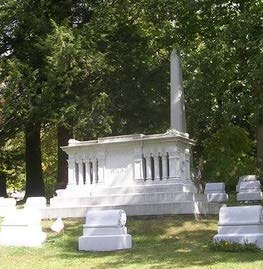
Mead Family Plot
Evergreen Cemetery, Rutland, VT
Ex. 8-008.
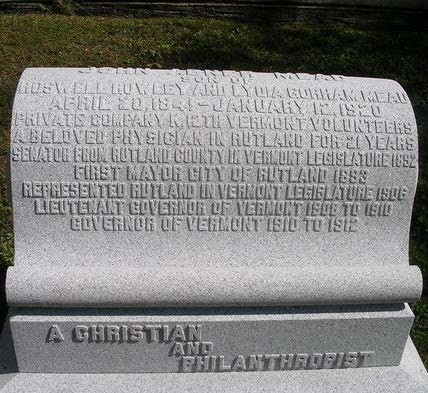
John Abner Mead (1841-1920)
“A CHRISTIAN AND PHILANTHROPIST”
Ex. 8-008.
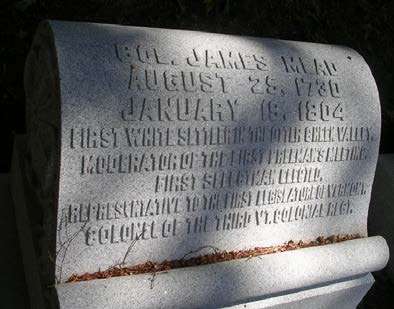
Colonel James Mead (1730-1804)
Ex. 8-008.
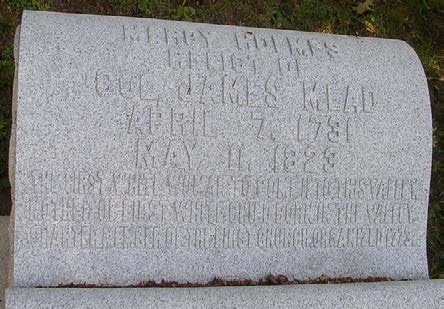
Mercy Holmes Mead (1731-1823)
Ex. 8-008.
MEAD MEMORIAL CHAPEL
A. John Abner Mead’s Offer to Middlebury College
95. On May 11, 1914, John Abner Mead sent a Letter to Rev. Dr. John M. Thomas, President of Middlebury College, offering to erect a chapel to serve as a place of worship for the college, the same to be known as the “Mead Memorial Chapel.” (hereinafter “Offer Letter”). Ex. 1-001 to 1-002.
96. The Offer Letter was also referred to as the “Letter of Gift.” Ex. 1- 001 to 1-002.
97. In the Offer Letter or Letter of Gift, Mead offered “to erect a chapel to serve as a place of worship for the college,” pledging $50,000 - $60,000 and specifying the Terms of the Contract, or, in the alternative, the Conditions of the Gift, which were:
A. Naming rights - the Chapel was to be known as the “Mead Memorial Chapel” to honor the Mead family ancestors who embodied the simplicity and strength of character, deep religious faith and connection to the Otter Creek Valley and Vermont that the Chapel was designed to symbolize.
B. Design Approval – Mead described “a dignified and substantial structure in harmony with the other buildings of the college” and suggested the Board “secure appropriate plans for its erection which shall meet with my approval.”
C. Building Committee – Mead suggested the Board appoint a Building Committee and named the composition of the committee in order to control contracting and supervision of construction.
D. Site Location – Mead specified the location of the building, “that it might rise from the highest point on its campus as a symbol.”
Ex. 1-001 to 1-002.
98. Mead’s hand-corrected and signed Offer Letter follows:

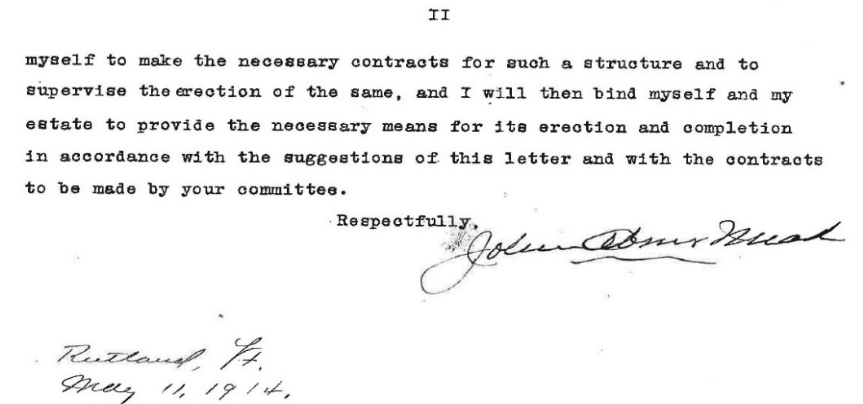
Ex. 1-001 to 1-002.
99. On May 15, 1914, President Thomas sent a copy of John A. Mead’s Offer Letter to the Trustees of Middlebury College announcing:
Your associate, Governor John A. Mead, has made it possible for me to make an announcement which will bring you all great satisfaction and encouragement, as it gives me the keenest pleasure. I enclose a copy of his letter to be signed May 11 th which assures the erection of an appropriate and beautiful chapel for Middlebury College.
I have testified many times to the great need of such a building and the large possibilities for good in connection with it. We have all felt for many years that it was one of the most urgent needs of the college, and those who have been closest in touch with the daily life of the institution have felt the need most earnestly.
P.S. May I hear from you immediately as to whether you will authorize the acceptance of Governor Mead’s proposition and the appointment of the Building Committee which he suggests.
Ex. 1-003.
B. Middlebury College’s Acceptance
100. On May 16, 1914, Trustee Frank C. Partridge wrote to President Thomas agreeing to accept the Offer and appoint of the Mead Memorial Chapel Building Committee as Mead had specified:
Your good news is received and I am delighted that your dream of a new chapel is to be realized. It is a generous and beautiful thing for Governor Mead to do and of course I agree, as one of the Trustees, to the acceptance of his proposition and the appointment of the building committee which he suggests.
Ex. 1-004 (emphasis supplied).
101. On May 17, 1914, Trustee John E. Weeks wrote to Mead with:
[congratulations and thanks for] . . . the splendid gift to Middlebury College. This is a most worthy reminder of your great loyalty to this Institution and one that can and will be instrumental in great good to this student body as long as time lasts. . . Your honorable public career is certainly crowned by this act.
Ex. 1-005 (emphasis supplied).
102. On May 18, 1914, Trustee A. Barton Hepburn wrote to Mead stating:
It is a splendid, well-considered and generous action on your part. It shows you possess that love for Alma Mater, which is one of the greatest charms of college life, the essence of college spirit; it shows your respect and reverence for your forebears, which is one of the highest qualifications a man may possess, and it shows, also, your disposition to do a good and useful act for the community in which you live and the State which you honor and which has bestowed its highest honor upon you. Congratulations and thanks.
Ex. 1-006 (emphasis supplied).
103. On May 19, 1914, Trustee James L. Barton wrote to Mead stating:
I can hardly describe to you the thrill of satisfaction that I experienced when a letter from Dr. Thomas reported your magnificent gift to Middlebury College in the form of a Memorial Chapel. I know of nothing more fitting as a memorial – nothing that will be of greater value to the College in all the years to come. I know of no building that could be put up out from which will go more fundamental and permanent influences for social, civic and national righteousness, for our own country and for the world. I want to express my deep personal appreciation of this gift, as well as my appreciation as a member of the Board of Trustees. I am sure you will get great satisfaction in seeing the walls of the building rise, as you realize what they mean to the College, the State, the country and the world, in all the years to come.
Ex. 1-007 (emphasis supplied).
104. On May 22, 1914, Trustee Brainerd Kellogg wrote to President Thomas, stating:
I can’t tell you how pleased I was and am at the news that Governor Mead wishes to build a Chapel on the College grounds. I had not thought that he dreamed of it.
And how fitting that it should be at the semi-centennial of his graduation – showing that his love for his College has not waned but waxed during the 50 years. . . .
Convey to him, please, my personal thanks for his generous plans. Of course the Trustees will allow him his ways, and will be everlastingly grateful to him in taking it.
Ex. 1-008 (emphasis supplied).
105. On May 23, 1914, John A, Fletcher, Treasurer of Middlebury College, wrote to President Thomas stating:
Replying formally to the welcome news contained in your message of the 15th , I wish to concur in the acceptance of the “Mead Memorial Chapel.”
It is a splendid gift . . .
I trust that the General Education Board will now look with favor
upon your application for a grant toward a new fund, on contemplating
this new evidence of the substantial and loyal support of our alumni.
Ex. 1-009 (emphasis supplied).
106. On June 22, 1914, the President and Fellows of Middlebury College (Board of Trustees) met and recorded the following resolution, which Board action formally accepted Dr. Mead’s Offer Letter to erect the “Mead Memorial Chapel” and the terms of the contract or conditions of the gift without reservation:
The following resolution, introduced by Dr. Brainerd, on motion of Dr. Barton & Prof. Kellogg, was adopted by a rising vote:-
“Whereas our esteemed colleague, the Honorable John Abner Mead of the Class of 1864, has signified to President Thomas his desire, in commemoration of the fiftieth anniversary of his graduation, to erect a Chapel for Middlebury College, and his readiness to furnish the sum of from fifty thousand to sixty thousand dollars for the erection of such an edifice,
Resolved that the President and Fellows of Middlebury College hereby accept of this magnificent benefaction with sincere gratitude to both Dr. & Mrs. Mead and their family for their deep interest in the religious welfare of the College, so impressively manifested by this provision of a suitable place for divine worship.
Resolved that the Trustees through the Committee nominated by Dr. Mead will use their best endeavors to secure the erection of a dignified and substantial structure, in harmony with the other buildings of the college, and such as will meet the approval of the donor.”
Dr. Mead made fitting response to this resolution. His letter of presentation follows in full:-
[Letter of Gift copied by hand verbatim
with quotation marks around
“Mead Memorial Chapel”]
On motion of Mr. Partridge, seconded by Dr. Abernathy, the Building Committee for the Mead Chapel was elected as above, Messrs. Thomas, Brainerd, Mead and Weeks.
Mr. Collins of the architectural firm of Allen & Collins then appeared before the Board with tentative plans for the new Chapel, which were discussed at length.
Ex. 1-010 to 1-012 (emphasis supplied).
C. Press Coverage
107. The gift of the Mead Memorial Chapel was widely reported in the Vermont press and Dr. Mead’s Offer Letter was reprinted in several news articles. See Exs. 1-013 to 018.
108. The Free Press had a special report from Middlebury, May 15, 1914:
EX-GOV MEAD GIVES
COLLEGE A CHAPEL
President Thomas of Middlebury Announces
Offer of $60,000 for Memorial.
Former Vermont Chief Executive Commemorates
50th Anniversary of His Graduation.
Middlebury, May 15 - President John M. Thomas announced this evening at a meeting at the gymnasium the gift of a $60,000 memorial chapel by ex-Governor John A. Mead of Rutland, to be called the Mead Memorial Chapel. The unexpected announcement was greeted with great enthusiasm.
Ex-Governor Mead was cheered by the gathering of 500 persons.
Ex. 1-013 to 1-014.
109. On May 16, 1914, the Rutland Herald reported on the gift:
DR. MEAD’S GIFT TO MIDDLEBURY COLLEGE
. . .
The gift of a chapel, in which the eternal Truth may be taught, and
devoted to the sacred purposes of divine worship, is an admirable
expression of active piety and reflects creditably upon its donor.
. . .
It is peculiarly fitting that Dr. Mead should thus recognize
Middlebury College, an institution so peculiarly a part of his native state
and his personal environment, for the reason that, as he sets forth in his
letter of gift, his great-great-grandfather was the first white settler in the
Otter Creek valley, and brought the Bible, in all its sublime and uplifting
beauty, to the peaceful Indians of the wilderness.
The college, too, which has made for itself an enduring name and place in Vermont’s institutions of education and uplift, must feel, through its faculty and student body, a peculiar pleasure in accepting the Mead Memorial Chapel as an expression of native patriotism and appreciation from a citizen who has been honored with the highest executive office in the gift of his state.
The Herald, for its readers, heartily joins in the sincere approbation and praise which this gift will justly inspire.
Ex. 1-017 (emphasis supplied).
110. On May 20, 1914, The Middlebury Campus’ news article described the enthusiastic response by the faculty and students to the announcement of Dr. Mead’s gift of the Mead Memorial Chapel. The article also reprinted Dr. Mead’s Offer Letter in full and then reported in part:
A NEW CHAPEL
There could be no question of the hearty gratification which this letter evoked from all present. Cheer-leader Dade took the platform and the “long Middlebury” resounded for Middlebury’s latest benefactor. Every one felt that a gift of great significance and importance had come at a most opportune moment, and as the donor spoke of his love for the college and feeling of gratitude towards her, of his early struggles to secure an education and his strong desire to see the work of the college perpetuated, the meaning of the gift became clearer to all.
Ex. 1-018.
A NEW CHAPEL
111. The Vermont Tribune’s May 21, 1914 edition also described Ex-Gov. Mead’s gift to Middlebury College and reported:
Ex. 1-019. (Emphasis supplied)
12. President Thomas wrote an article that was published in the April 8, 1915 edition of the Boston Evening Transcript, entitled MIDDLEBURY’S 100 YEARS, Old Traditions Preserved in New Chapel” in which he explained:
The proposal of ex-Governor John A. Mead to erect a chapel for Middlebury in commemoration of the fiftieth anniversary of his graduation . . . in his letter of gift ex-Governor Mead had said, “I have in mind a dignified and substantial structure, in harmony with the other buildings of the college, and expressive of the simplicity and strength of character for which the inhabitants of this valley and the State of Vermont have always been distinguished.” He asked that the chapel to bear his name might “rise from the highest point of the campus, as a symbol of the position, most prominent in every respect, which Christian character and religious faith should always maintain in its work for our youth.”
The chapel will occupy a commanding location on the grounds on the highest crest of the campus, from which point there is a wide panorama of the Green Mountains and the valley of Otter Creek. On the architrave over the colonnade will be appropriately inscribed “The Strength of the Hills is His Also.”
Exhibit 43 (emphasis supplied).
D. 1914 Groundbreaking & Cornerstone Ceremony
113. On May 28, 1914, John Mead wrote to President Thomas regarding arrangements for the groundbreaking and laying of the cornerstone for the Chapel. Dr. Mead requested a piece of sod to place in the Evergreen Cemetery in his family’s burial lot and indicated, “We will have the little box with the bible which little John is to place in the stone all properly arranged.” Ex. 2-001 to 2- 002.
114. On June 23, 1914, Middlebury College held a ceremony titled “Breaking Ground for the Mead Memorial Chapel and Presentation of the Corner Stone” during its commencement exercises. Ex. 2-003.
115. Ex-Governor John A. Mead, Class of 1864, gave the speech for the “Breaking Ground and Presentation of the Corner Stone,” (See Ex. 2-004 to 2- 026) which he concluded with:
On this date, I wish to break the ground and place the corner stone for this Memorial Chapel, with the hope and prayer that there shall be a sacred duty resting upon each, to make this Holy Temple, so soon to be erected, an instrument of great good to those of this generation and to those who may follow after, and that our Alma Mater may be favored by steadily increasing numbers and with ample means for the noble work which will devolve upon her, and all of which she will attempt so willingly, so courageously and so faithfully.
Ex. 2-019 (emphasis supplied).
116. The Rev. James L. Barton, D.D., LL.D., Class of 1881 delivered the “Acceptance in Behalf of the Trustees” (Ex. 2-021 to 2-026) in which he stated:
I am honored in being permitted, upon behalf of the trustees of Middlebury College, to accept from the hands of one of their number, a graduate of the College and a revered citizen of this commonwealth, this corner stone and that for which it stands, namely, a fitting chapel to be erected upon this site to embody and represent and perpetuate the religious life of this College.
It is doubly gratifying to me, as it is to the Board of Trustees, that this building, as a memorial, will bear the name of one so long and so honorably connected with this institution and who in the state and nation has always upheld and promoted true piety and civic and national righteousness.
. . . Today we see the religious ideals of our forefathers emancipated and exalted to this loftier position and embodied in a structure worthy the College and its resplendent history. Here upon this hilltop it will, by the outlines and symmetry of its architecture, proclaim that this College believes in God, in the supremacy of righteousness, in the creation of a safe, sane and just society, the triumph of justice, the transcendent worth of character, the reality of the unseen, and in the immortality of the soul.
This chapel will provide for the generations of students and faculties of this college that to which the other buildings cannot minister. To this place all will turn in order to experience the reality of the unseen, to satisfy the thirst of the soul for God.
We then, the Trustees of this College, on behalf of ourselves and our successors, in the name of the generations of students it will serve, in full recognition of the supreme importance of such a religious center to the life of the institution, and in loving memory of him whose name this structure is to bear, gratefully accept at your hand this Chapel as we pledge ourselves to safeguard to the limit of our capacity the gift and the ideals it is intended to perpetuate.
Ex. 2-021 to 2-026 (emphasis supplied).
117. Prof. Charles B. Wright gave an “Address in Behalf of the Faculty” (Ex. 2-027 to 2-029) which he ended with the statement:
Such an embodiment should this structure be...a chapel whose very lines, I trust, as they rise upon this summit, may prove for us all in the years to come a compelling call to goodness; whose very atmosphere, I trust, may dispose our hearts to praise – shall be but a fit expression, a symbol in stone, of the mingled strength and beauty of the Middlebury life.
The Faculty thank you, Governor Mead, from profoundly grateful hearts. You have bodied forth our dream of years; you have given to an airy nothing a local habitation – and not the least of our pleasure is the thought that through all the days to be it will bear your honored name.
Ex. 2-028 to 2-029 (emphasis supplied).
118. Among the guests of the College at the ceremony were Miss Katherine Lee Bates, Professor of English at Wellesley College. Bates was also a social activist interested in the struggles of women, workers, people of color, tenement residents, immigrants, and poor people. She helped organize the Denison House, a college women's settlement house, with other women friends and colleagues in 1892. She also wrote and spoke extensively about the need for social reform and was an avid advocate for the global peace movement that emerged after World War I.
119. The Cornerstone for the Mead Memorial Chapel was laid at the Groundbreaking Ceremony held on June 23, 1914, where John Abner Mead’s namesake, his 3-year-old grandson John Abner Mead Hinsman (“Little John”), placed his small Bible and family tree back to original settler Colonel James Mead into a box inside the Mead Memorial Chapel Cornerstone. The Ceremony was widely reported on in the press. Exs. 2-032 to 037.
120. Photographs of the Groundbreaking Ceremony still exist
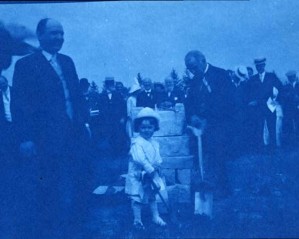
Ex. 2-030 – Carl B. Hinsman, John Abner Mead Hinsman (“Little John”), and Gov. John Mead “breaking ground” for Mead Memorial Chapel
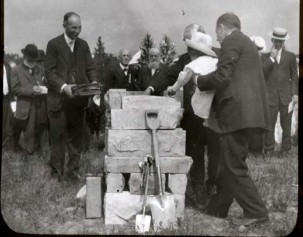
Ex. 2-031– Pres. Thomas (left holding Mead Family Bible), Mead & “Little John” held by his father Carl B. Hinsman placing Bible in Cornerstone
121. The Mead Family Bible, held by President Thomas at the Groundbreaking ceremony photographed above, has been passed down through the generations of the Mead family and resides with Mead family members who live in Vermont:
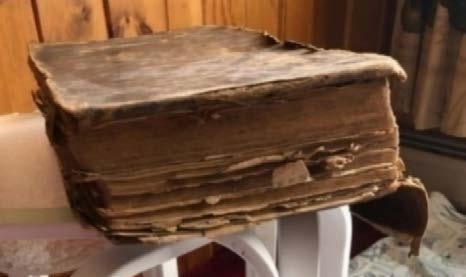
Ex. 8-003.
E. Chapel Construction and Costs: 1914-1916
122. The construction of the Mead Memorial Chapel proceeded over the next two years, during which time Dr. Mead attended meetings of the Mead Memorial Chapel Building Committee in Middlebury, met with architects, approved project designs, controlled the budget, and provided credit and payment for all labor and materials. Ex. 3-001 to 3-053.
123. Besides the costs of the Chapel building itself, Dr. Mead contracted and paid for a $5,000 pipe organ, $1,031 for Pilasters, and $1,559.39 for pews. Ex. 3-005 to 3-006, Ex. 3-021, Ex. 3-040, Ex. 3-048 to 3-050.
124. On June 21, 1915 Dr. Mead sent an additional Offer Letter to President Thomas pledging an additional $7,000 for a Chime of Bells stating: “If acceptable to the members of the Board of Trustees, Mrs. Mead and I would be pleased to add a chime of bells to our gift of the Mead Memorial Chapel.” Ex. 3- 034 to 3-036, Ex. 3-038, Ex. 3-039, Ex. 3-041 to 3-043.
125. Dr. and Mrs. Mead’s addition gift of a Carillon of Bells was installed in the Chapel tower. There were eleven bells, the largest weighing 2500 pounds and the smallest 275 pounds. Each bell bears the inscription:
“Presented to Middlebury College by John Abner and Mary Sherman Mead.”
“Ring in the valiant man and free, The larger heart, the kindlier hand; Ring out the darkness of the land, Ring in the Christ that is to be.”
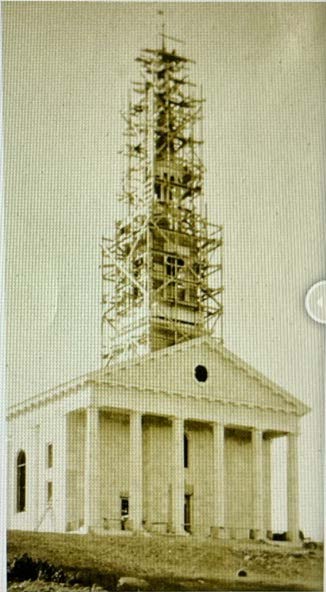
Ex. 6-012.
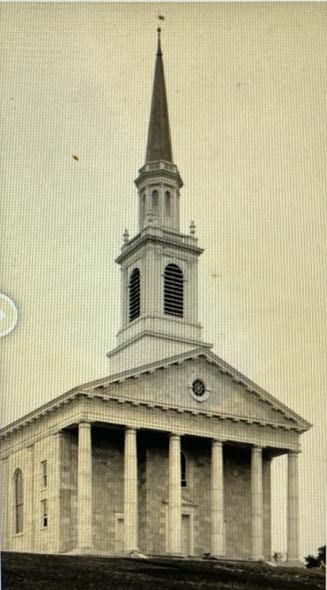
image-052.jpg
126. The Mead Chapel was the work of Allen and Collens of Boston. It draws freely upon the vocabularies of the American classical styles of the 18th and 19th centuries in its translation of the traditional New England meeting house into marble. Thus, one finds a Greek Revival temple front, Georgian doors and windows, and a Federal tower. Above the colonnade is inscribed a quotation from Psalm 95:4, “The strength of the hills is His also.” Within the building is a beautiful Georgian-inspired paneled sanctuary:
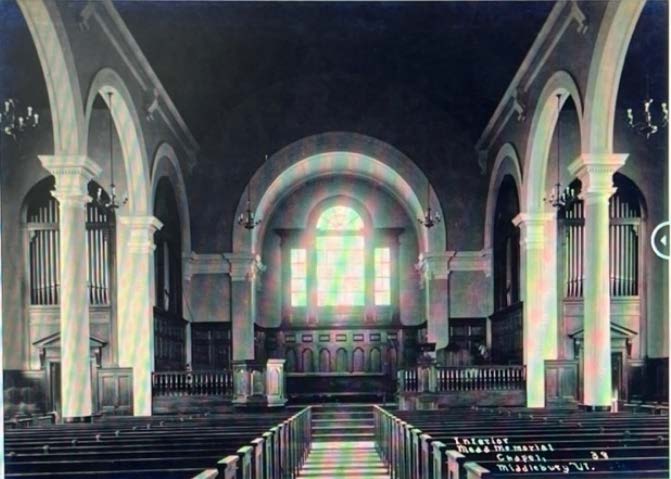
Ex. 6-014 - Mead Memorial Chapel – interior view upon completion.
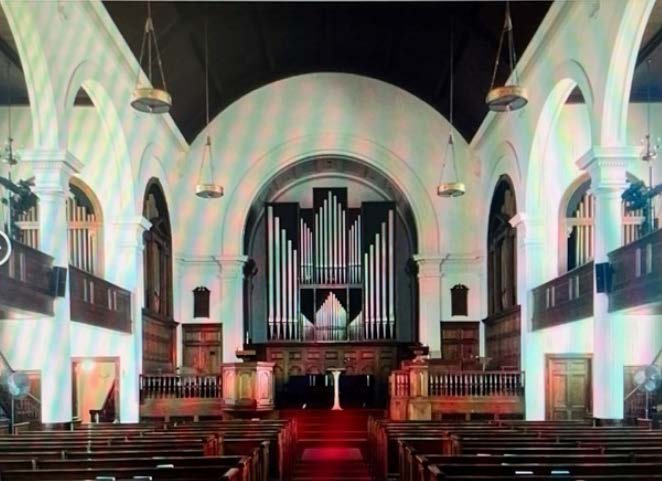
Ex. 6-014 - Mead Memorial Chapel – current interior view
127. Construction was completed in 1916 and the final cost paid by Dr. Mead to construct the Chapel was $75,373.34, present value of which is $2,237,058.12. Ex. 3-048 to 3-050.
128. However, the current value of the Mead Memorial Chapel, as well as the replacement costs to construct the Chapel, exponentially exceed and eclipse that number.
129. President Thomas would later recount while Eulogizing Governor Mead at his funeral in 1921:
For a year and a half we worked together in the consideration of plans and details and the result was a structure which a professor of Yale College pronounced the other day one of the most beautiful buildings in North America. Stately, reverent, graceful, combining the classic beauty of ancient Greece, the chaste dignity of our Puritan fathers, and the mystic impressiveness of the early Christian builders, its daily assemblies make subtle impressions on the youth who gather there speaks to them without other voice of “the light that never was on land or sea.”
Exhibit 8-034 to 8-035 (emphasis supplied).
130. As the College grew, changes were inevitable. The balconies were added in 1938, increasing the seating capacity to 715. An altar replaced the original armchairs at the back of the chancel in 1952. The little Sunderland Chapel was created at the right, and is used for small prayer meetings. The original organ was replaced in 1971 by the large Gress-Miles organ. The tower now holds a wonderful 48-bell carillon, cast and tuned in France from the original bells and other sets. It is played regularly in the late afternoon. See Ex. 6-001 to 6-005.
F. 1916 Dedication Ceremony & Presentation of the Keys
131. The Mead Memorial Chapel Dedication Ceremony was held on June 18, 1916 during which Dr. Mead made a Presentation Speech, recalling his grandson’s role in the Groundbreaking and Setting of the Cornerstone two years earlier, when at 3 years old, “Little John” placed his Bible and family tree in the cornerstone:
With the labor of love and devotion all complete, it is with great pleasure and an honor that I, through him who assisted me some two years since “in removing the soil” for the “setting of the corner stone”, and who placed under the same his token of love, - his Bible and a short history of his relation to those who made this Temple possible; as I state, it is with pleasure, that through him, I may present to you, Doctor Brainerd, former President of this College, the keys to the Mead Memorial Chapel, - and may the Kind Providence who governs all our efforts for the greatest good and happiness of his children, give you all strength and wisdom, - that your and our fondest and most extravagant anticipations of this day may be more than realized, in the years that are to come.
Ex. 4-007 to 4-008.
132. Mead’s speech was followed by “Little John,” now 5-years, presenting the Keys to the Mead Memorial Chapel to the College Trustees. Ex.4- 011.
133. Dr. Brainerd, Former President of Middlebury College accepted the Keys on behalf of the Trustees and stated the following in his acceptance speech:
Doctor Mead:-
I esteem it a great privilege to appear in behalf of the President and Fellows of Middlebury College and accept publicly, your gift of this beautiful sanctuary, that we have this day met to dedicate to the service of Almighty God. For many years, especially since the old chapel proved too small to hold even the half of our students, it has been the fond hope and the earnest prayer of the friends of the College, that in God’s providence there might appear a man of the religious fervor and the financial ability requisite to meet this urgent need for a larger and more suitable edifice. Today our ardent hopes are realized; our prayers are graciously answered. And to me it is especially gratifying that our benefactor is my beloved classmate, one to whom I am bound, now for fifty six years, by ties of the warmest friendship.
During these many years (which have passed with us so swiftly) the Heavenly Father has been pleased to grant you strength of mind and body, and varied opportunities for doing great service to your fellowmen. How well I recall the patriotic zeal with which, while yet a student in college, you enlisted in the war to maintain the union of these United States. [Unreadable word] later, as a well- trained physician, you served in another war—against the diseases that distress mankind; and by sound judgement and kindly sympathy achieved an enviable reputation in his beneficent calling. Still later your executive talent enabled you to build up a great industry, whose products are now used in every civilized portion of the world. More recently you served the commonwealth of Vermont, in the highest public office, with business sagacity, with fidelity, and with honor. But the noblest deed of all---the one for which future generations will hold you most in grateful remembrance---is the erection of this spacious and attractive chapel, where the religious life of the College may find fitting expression and the stimulus of hallowed associations.
With grateful hearts, dear brother, we accept your generous gift: and we assure you of our earnest purpose so to utilize its opportunities for religious culture, as to promote the growth of earnest Christian character in the students of Middlebury College.- --Here for generations yet to come the melodious bells of this Chapel shall sound out over the Campus and the Town the strains of Christian music, that from childhood have awakened in our souls the sentiments of faith and courage and earnest living.
The lord reward you, dear friend, for all that you have done, or may yet do, for the good of others; and may the years of earthly life that still remain be your best years, filled with blessed memories and abiding peace.
Ex. 4-011 to 4-017.
134. The 1916 Kaleidoscope, the Middlebury College Annual was dedicated to Governor Mead:
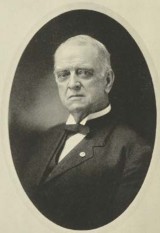
Ex. 4-020.
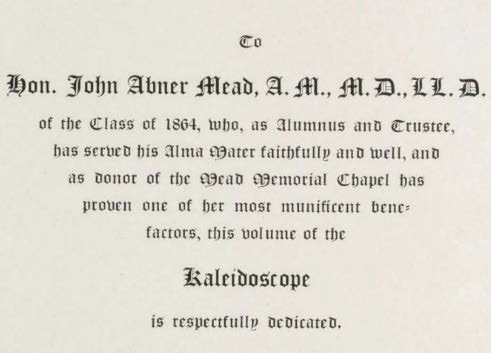
Ex. 4-020 - 1916 Kaleidoscope
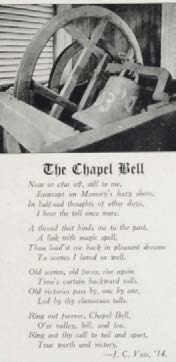
Ex. 4-026.
135. On September 19, 1916, President Thomas sent invitation to Dr. Mead and his family to attend the first assembly of students at the Mead Memorial Chapel:
We have our opening Thursday morning of this week at nine o’clock. All the faculty and students will be together in the new chapel and I am expected to make an opening address. I am sure it would do much to this first assembly of students in the Mead Memorial Chapel if you and Mrs. Mead could be present, especially if you could bring little John and his father and mother. I know you are very busy, and of course I would not impose it as a duty, but if you can run up we will all be very glad to see you.
Ex. 4-027.
136. President Thomas’ Address to the first assembly of students in the Mead Memorial Chapel on September 19, 1916 began:
At the opening of the 117th year of Middlebury College and at this first student assembly in this stately and beautiful chapel, whose dignity and impressiveness must move us all to serious and earnest thought, I wish to sound a note of progress in the things which make up the inner life of a college.
. . . Surprise as well as admiration is expressed by every visitor to this Mead Memorial Chapel . . . They had not imagined that such structures had been erected for any college in Vermont.
Ex. 4-032.
137. At Governor Mead’s funeral on January 16, 1920, Middlebury College President John M. Thomas gave the Eulogy which was published in its entirety in the Middlebury Register the next day and stated in part:
As to his gift of the Mead Memorial Chapel, I can not do better than to quote from the letter in which he announced his purpose.
[Full text of Mead’s Offer Letter]
This afternoon, as we pay here our tribute of honor and affection, the chimes which bear his name on every bell are sounding out the hymns I loved and which he chose to hear the first time they were played, “Nearer my god to Thee”, “Lead Kindly Light”, “God be with you ‘till we meet again”. The dedication of the Chapel is complete – The Mead Memorial Chapel.
So our friend built his empire in our midst. If another could have built it, another did not. He loved his work and he gave his all to it to the very last. He carved his name high in the marvelous roll of Vermont's men of achievement, and he earned his rest.
Ex. 8-034 to 8-035.
G. The Mead Memorial Chapel - Historical Use, Value & Enrichment to the College
138. Middlebury College’s website explains the import and significance of the Mead Memorial Chapel (now referred to as the “Middlebury Chapel”), which symbolizes the aspirations of the College, just as Governor Mead intended:

“This beautiful white marble structure rises on
the highest point of the campus, its spire
symbolizing the aspirations of the College.”
“The light which shines here nightly is seen in the entire valley.
Over the portal are carved the words from Psalm 95:4,
“The Strength of the Hills is His Also.’”
Ex. 6-001.
139. Middlebury College celebrated the Mead Memorial Chapel’s Centennial in 2016 with a video production entitled “Mead Chapel Turns 100,” featuring Middlebury College’s Glenn Andres, Professor Emeritus, History of Art and Architecture, in which he details the history, symbolism and importance of the “Mead Memorial Chapel” to Middlebury College, stating as follows:
“We are here to celebrate Mead Chapel, which is marking its centennial year.”
“This beautiful building was a key part of President Thomas’ vision for Middlebury College. President Thomas noted that the Chapel room, when he became president, was merely a room and it only accommodated about ½ of the student body which at the time was 222 students.”

“But then in May 1914, ex-Governor John Mead of Rutland pledged $60k to the college to construct a chapel.”
“He expressed a desire that this Chapel be built on the highest point on the campus to catch the first rays of morning light and the last glow of the evening sun. He wanted it to be executed in Vermont marble. He wanted it also to ‘be expressive of the simplicity and strength of character for which the inhabitants of this valley and the state of Vermont have always be distinguished.’”
“These references to strength and to place are probably the source of the quotation that we find on the portico on the Chapel, ‘The strength of the hills is His also.’ This is Psalm 95.”

“The building was initiated in 1916 with a seating capacity of 674 at a time that the college had 222 students. The building was primarily used for daily Chapel services, it was a time for announcements, for hymns, for reading scriptures, and a five minute talk. This was delivered by visiting clergy and sometimes by faculty members.”
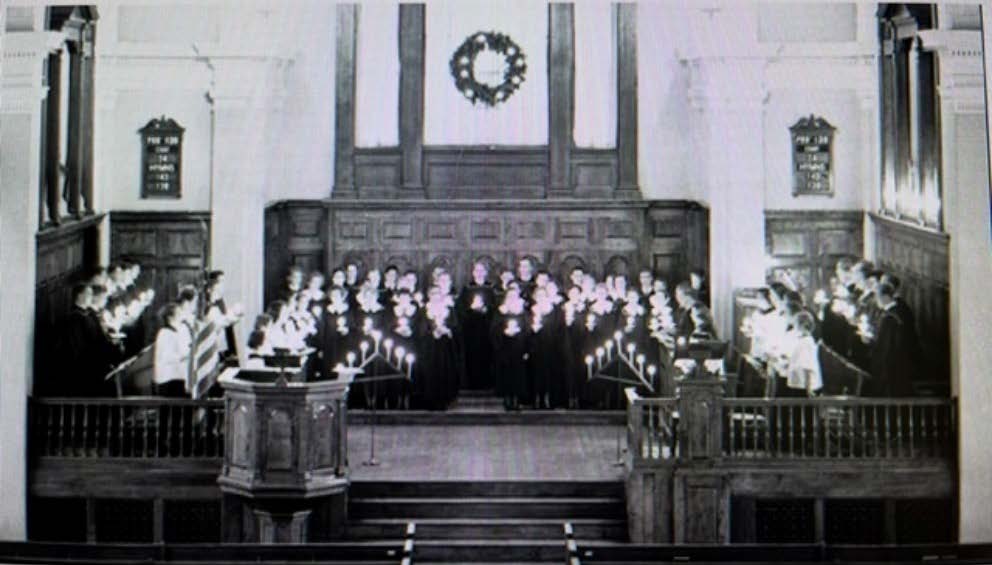
“By 1950, with a student population of 1200, Chapel was required only every other day because they couldn’t accommodate the whole campus. And then in the 1960’s, compulsory Chapel ceased.”
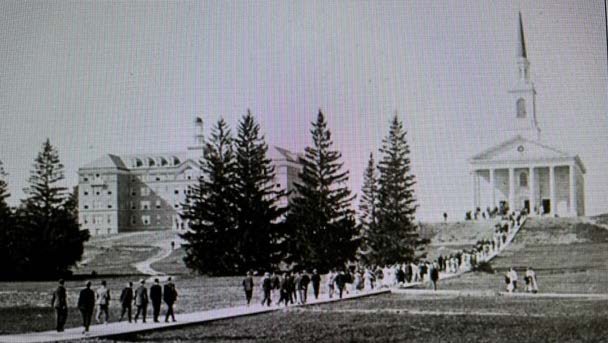
“But the Chapel has continued to function in accord with President Thomas’ larger vision of it as the college’s meeting house. Of course it remained a place for Sunday services, for weddings, but also for college ceremonies, convocation, baccalaureate and until the completion of the Center for the Arts, it was also the main venue for the college concert series.”
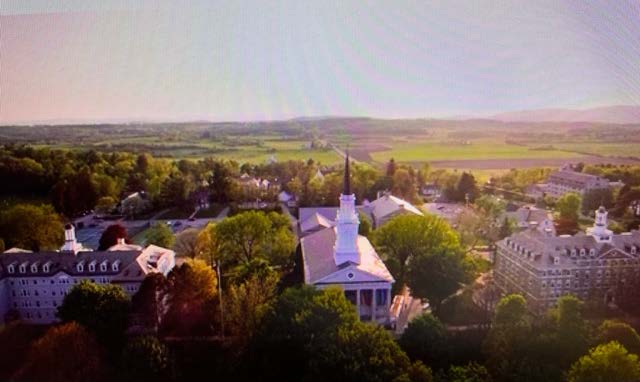
“The monumental centerpiece and aesthetic keystone for the college for 100 years, Mead Chapel has remained an important symbolic and central venue for college activities and traditions.”
Middlebury College Video: Mead Chapel Turns 100, June 15, 2016, Glenn Andres, Middlebury
College Professor Emeritus, History of Art and Architecture, 2016, (emphasis supplied).
https://www.middlebury.edu/announcements/news/2016/06/video-mead-chapel-turns-100
Exhibit 6-012.
140. Middlebury College’s website further confirms the vital role and significance that the Mead Memorial Chapel has played in the college’s history:
“Mead Chapel, perhaps the most iconic building on the Middlebury College campus, has been part of every student’s experience for the past century, providing a community gathering place for convocations, lectures, concerts, baccalaureates, and countless other events.”
Beginning in 1937, a Chaplain was appointed to lead the Chapel services, organize the Sunday Vespers with their visiting clergymen, and encourage the religious life of the College. The Chapel currently has a Christian chaplain and two associate chaplains, one a rabbi and one a Muslim advisor.
Ex. 6-001 to 6-005.
141. In addition to the value of the building itself, the Mead Memorial Chapel was critical in establishing financial support from the State Board of Education as referenced by Treasurer John Fletcher’s correspondence concurring with the acceptance of Mead’s offer to build the Mead Memorial Chapel. See Ex. 1-009 (“I trust that the General Education Board will now look with favor upon your application for a grant toward a new fund, on contemplating this new evidence of the substantial and loyal support of our alumni.”)
142. Even the Middlebury Campus newspaper reported on the importance of the gift of the Mead Memorial Chapel, recognizing its significance to the college’s solvency, reputation and its impact in inspiring additional financial support and placing Middlebury College back on the road of progress:
. . . Every one felt that a gift of great significance and importance had come at a most opportune moment. . . And so Middlebury starts out on the road of progress once more, or rather continues steadily to advance despite discouragements and apparent setbacks. After the completion of the General Educafion [sic.] Board fund of $200,000 and the Carnegie report, it looked as if progress was at an end for a time, and that the college would be forced to battle to keep even. Governor Mead has changed all that. His gift will inspire every friend of Middlebury to courage and optimism, and everyone will believe that still other gifts and yet more notable advance are to be the order of the day.
Ex. 1-018 (emphasis supplied).
143. Moreover, Governor Mead successfully encouraged others donors to support the College and used the Mead Memorial Chapel to inspire “our friend” to make a significant gift of a Boy’s Dormitory. Ex. 5-001.
144. And apparently, that “friend,” A. Barton Hepburn, Chairman of the Board of The Chase National Bank in New York, Middlebury College Alumnus (1871), Middlebury College Trustee from 1905-1922 and one of the Trustees who accepted the Mead Memorial Chapel offer in 1914 (See Ex. 1-006), personally provided the funds in 1915 to construct Hepburn Hall, the Boy’s Dormitory, which is named for him.
145. After the Mead Memorial Chapel was built in 1916, Dr. Mead provided President Thomas with photos and other materials documenting the construction of the Chapel so President Thomas could create a booklet which, according to Mead, “might stimulate some of our friends to pattern after Mr. Hepburn’s example and give you an elegant dormitory for the girls or possibly something else which you might more desire at this time.” Ex. 5-003 to 5-007.
146. Mead offered to pay the cost of publication of the booklet and wrote to President Thomas, “To be frank with you, I have special hopes that it may be productive of great good to our college, as I do feel that others can be made specially interested in our Alma Mater, and that the full history and description of the Chapel should induce others to lend a helping hand.” Ex. 5-006 to 5-007.
147. The value and importance of the Mead Memorial Chapel to Middlebury College cannot be overstated. Erected as a place of divine worship and a meeting house for the college community, it is a structure of great beauty and stature that served as catalyst to encourage other significant private donations as well as public moneys to flow to the college.
148. But most importantly, the Mead Memorial Chapel became “[t]he monumental centerpiece and aesthetic keystone for the college for 100 years,” (Ex. 6-006 to 6-007) not only standing as the most dominant building on the campus and an iconic feature of Middlebury's landscape, but also serving as the College’s identity and brand, with “its spire symbolizing the aspirations of the College.” Ex. 6-001 to 6-005
149. It is that identity and iconic imagery, first publicized by President Thomas’ 1915 article in the Boston Evening Transcript, that has succeeded as a brand and marketing tool to attract students and increase enrollment for more than a century.
H. Middlebury College’s Removal of The Mead Family Name From The Mead Memorial Chapel
150. Governor Mead constructed and dedicated the Chapel, and the President and Trustees of Middlebury College accepted it to serve as a suitable place for divine worship at the College. An essential term, obligation, promise, and condition of their agreement was that the Chapel would be known as “The Mead Memorial Chapel” in honor of the Mead ancestors. Ex. 1-001.
151. The President and Trustees of Middlebury College honored their commitment to the essential term, obligation, promise and condition that the Chapel be known as the “Mead Memorial Chapel” for over 100 years.
152. Then on or about the summer of 2021, the Prudential Committee of the Board of Trustees of Middlebury College, voted to remove the Mead name from the Mead Memorial Chapel because, they claimed:
In 1912, two years before the chapel gift was made, in his outgoing speech as governor, John Mead strongly urged the legislature to adopt policies and create legislation premised on eugenics theory. His call to action resulted in a movement, legislation, public policy, and the founding of a Vermont state institution that sterilized people—based on their race, sex, ethnicity, economic status, and their perceived physical conditions and cognitive disabilities.
Ex. Ex. 7-005 to 7-010.
153. For reference, Governor Mead, received his medical degree in 1868, more than 153 years ago, which was 3 years after the end of the Civil War and 3 years before Charles Darwin published The Descent of Man in 1871.
154. In reality, Governor Mead’s so-called “urgent call to action” was nothing more than the following:
Let me, at this time, respectfully recommend to the legislature of 1912 that they at once take steps to safeguard and restrict the issuing of marriage licenses to persons convicted of rape, incest, open or gross lewdness, and cases where either of the parties are known to be suffering tuberculosis, syphilis, or epilepsy, and in cases where either party has been in confinement for habitual drunkenness, feeble-mindedness, or insanity.
And, I further recommend that a commission be appointed to investigate and report upon the advisability of the adoption of the operation of vasectomy as a prevention for the spread of hereditary taints and diseases.
Ex. 8-022.
155. No legislation was signed into law in Vermont as a result of Governor Mead’s Farewell Address.
156. In fact, not until almost two decades (19 years) later, on March 31, 1931, and more than a decade after Governor Mead’s death, did the Vermont Legislature pass "An act for human betterment by voluntary sterilization." The aim of the legislation was to prevent, through sterilization, the procreation of individuals judged to be idiots, imbeciles, feebleminded, or insane.
157. The tragic result of the 1931 legislation was the eventual sterilization of 253 people in Vermont, most of whom were sterilized between 1931 and 1941.
158. Nonetheless, Middlebury College proclaimed Governor Mead a eugenicist, implying without evidence that his motivation was racism.
159. Middlebury College’s removal of the Mead family name from the Mead Memorial Chapel and the denigration of Governor Mead sullies the reputation of a decent man, as well as a generous benefactor of the College. The College’s September 27, 2021 Statement portrays Governor Mead as essentially a precursor of Hitler, rather than presenting him in the context of his time.
160. Support for eugenics was mainstream in the early 20th century, embraced by leaders in society, education and government, including Presidents, prime ministers, judges, and scientists and authors.
161. Helen Keller and the founder of Planned Parenthood supported the movement as did George Bernard Shaw, H. G. Wells, Henrik Ibsen, T. S. Eliot, Virginia Woolf, and John Maynard Keynes.
162. Moreover, the bulk of eugenics activity in Vermont occurred from 1931 to 1941, decades after the Governor’s address and more than a decade after his death.
163. Therefore, the College vastly overstates Governor Mead’s role in this matter, as if he were the mastermind of a movement instead of an outgoing Governor merely expressing his mainstream progressive views in his retiring message of 1912.
164. Vermont’s native son, Calvin Coolidge, observed: “Education is to teach men not what to think but how to think.” That requires hearing different ideas and acknowledging them in context. It means learning from history, not erasing it.
165. Purging the legacy of someone who revered Middlebury College and gave generously to support it, due to a single remark that we a century later deem unacceptable, hardly conforms to the purpose of the College. It certainly is no basis for breaching the essential term, obligation, promise and condition that the Chapel would be known as the “Mead Memorial Chapel” to memorialize the Mead family name and honor the Mead family ancestors who embodied the simplicity and strength of the Vermont character that the Mead Memorial Chapel was designed to symbolize.
I. “Cancel Culture” and the Erasure of History
166. Yale Professor Anthony Kronman, in his book “The Assault on American Excellence,” urges against erasure of history. Rather, he writes, we should “contextualize” it.1
167. Historical context refers to the social, religious, economic, and political conditions that existed during a certain time and place; those details enable us to interpret and analyze events of the past, rather than to merely judge them by contemporary standards. In analyzing historical events, context can help us understand what motivates people to behave as they did. Without historical context, we are only seeing a piece of the
1 The Assault on American Excellence (New York: The Free Press, 2019) from https://www.thefreelibrary.com/ARISTOCRATIC+EXCELLENCE%2c+SECULAR+ECUMENISM%2c+AN D+THE+LIFE+OF+THE...-a0661250331 scene and not fully understanding the influence of the time and place in which a situation occurred.2
168. However, instead of analyzing the remarks of Governor Mead from 1912, in the context of the social, religious, economic, and political conditions that existed in Vermont more than a century ago, Middlebury College has purged the good family name of a beloved and generous alumnus whose 100-year legacy it has erased, or, in contemporary parlance, “canceled.”
169. Vermont legal scholar Paul Gillies, Esq. examined this current phenomenon, explaining in his 2020 Vermont Bar Journal article, “Limitations of Law and History,” that:
Lately, the statues of Confederate generals and of those who promoted slavery have come down hard, toppled by protesters. Columbus has been decapitated and thrown into the river. Military bases, sports teams, and even the UVM library are being renamed, as a way of condemning racism and other wrongs, as a form of expiation or atonement. These judgments altering our view of people and events know no time limit, and there is no due process, no appeal, no hearing beyond the chanting of slogans. The sins and crimes of men and women found to be lacking in lasting respect are unforgivable and swiftly punished, justified by revisionist historical thinking and the mores of the present. Time never runs out on them.
We need to sort out just how severe to be with the dead respondents we seek to hold liable for their sins and opinions. Washington was a slave-owner. He was more than that, of course, but should the slave-owning part of his biography outweigh his other accomplishments, enough to order the removal of the Washington Monument? What about people who believed
2 Fleming, Grace. "The Importance of Historic Context in Analysis and Interpretation." ThoughtCo. https://www.thoughtco.com/what-is-historical-context-1857069
something now regarded with horror and then changed their minds? Suppose Guy Bailey later recanted his support of eugenics and persuaded the legislature to repeal the sterilization law. Could his name be retained on the [UVM] library wall?
Ex. 7-028.
170. John Abner Mead was a man of his time who did great good in the world. A mainstream progressive known to be a keen and shrewd observer, he was a man who preserved at all times independent and original judgment. That curiosity and analytical approach was reflected in Governor Mead’s Farewell Address in which he proposed studying and gathering more information regarding a more humane procedure called the vasectomy. Had Mead lived twenty more years, who is to say that he would not have come to a different opinion and persuaded the legislature to repeal the sterilization law?
171. But that is not the time period in which John Abner Mead lived. The problem with imposing our 21 st century world view on actors who lived over a century ago lies in judging and ostracizing them for mainstream views prevalent in the society of the time.
172. The removal of the Mead family name from Mead Memorial Chapel was unnecessary to right past wrongs. Instead of making amends for the racist remarks of its own President Paul Dwight Moody, who was at the helm of the College for over two decades from 1921-1942, directing its curriculum and its admissions for decades, Middlebury made a scapegoat of Governor Mead by disparaging his amazing legacy without any justification.
173. As a result, John Abner Mead’s lifetime of accomplishments and devotion to the betterment of others has been erased: His risking of his life to fight in the Civil War, his two decades of service as a beloved physician to his community, his economic development of the region and state and the employment opportunities and prosperity he provided for Vermonters, his financial support of the goal of making Middlebury College a world-class institution, his sharing of his wealth with the Rutland churches, and his gift of “The Community Center” which he insisted serve and welcome people of all faiths, evidencing his commitment to diversity a century before it came into vogue.
174. Moreover, the Mead family name has been unfairly erased - canceled by Middlebury College for sins that John Abner Mead never committed. However, unlike the Dorothy Canfield Fisher Award or the naming of the Bailey Library at UVM, which were honors bestowed voluntarily and which freely can be revoked, the name “Mead Memorial Chapel” was accepted by Middlebury College as being the forever name of the Chapel, in memory of the Mead family pioneers who embodied the simplicity and strength of the Vermont character that the Chapel was designed to symbolize, and who shared fellowship and community with the Native Americans, all of which was reflected in the central purpose of this Chapel and community meeting house.
175. The name “Mead Memorial Chapel” was the essence of the deal, and it was the entire deal – forever. That was the intent of the parties when the Mead Memorial Chapel was offered by John Abner Mead and accepted by the Middlebury College Board of Trustees as evidenced by:
Trustee John E. Weeks’ letter, (“This is a most worthy reminder of your great loyalty to this Institution and one that can and will be instrumental in great good to this student body as long as time lasts.”). Ex. 1-005.
b. Trustee A. Barton Hepburn’s letter, (“it shows your respect and reverence for your forebears”). Ex. 1-006.
c. Trustee James L. Barton’s letter, (“your magnificent gift to Middlebury College in the form of a Memorial Chapel. I know of nothing more fitting as a memorial – nothing that will be of greater value to the College in all the years to come. I know of no building that could be put up out from which will go more fundamental and permanent influences for social, civic and national righteousness, for our own country and for the world. . . I am sure you will get great satisfaction in seeing the walls of the building rise, as you realize what they mean to the College, the State, the country and the world, in all the years to come.”). Ex. 1-007.
Trustee Brainerd Kellogg’s letter, (Convey to him, please, my personal thanks for his generous plans. Of course, the Trustees will allow him his ways, and will be everlastingly grateful to him in taking it.). Ex. 1-008.
1914 Groundbreaking Ceremony - Rev. James L. Barton’s Acceptance Speech on behalf of the Trustees, (“It is doubly gratifying to me, as it is to the Board of Trustees, that this building, as a memorial, will bear the name of one so long and so honorably connected with this institution and who in the state and nation has always upheld and promoted true piety and civic and national righteousness. . .We then, the Trustees of this College, on behalf of ourselves and our successors, in the name of the generations of students it will serve, in full recognition of the supreme importance of such a religious center to the life of the institution, and in loving memory of him whose name this structure is to bear, gratefully accept at your hand this Chapel as we pledge ourselves to safeguard to the limit of our capacity the gift and the ideals it is intended to perpetuate.”). Ex. 1-020 to 1-026.
f. 1914 Groundbreaking Ceremony - Prof. Charles B. Wright’s Address on behalf of the Faculty, (“You have bodied forth our dream of years; you have given to an airy nothing a local habitation – and not the least of our pleasure is the thought that through all the days to be it will bear your honored name.”). Ex. 1-027 to 1-029.
176. Middlebury College’s removal of the name “Mead Memorial Chapel” was a breach of that agreement, a violation of that condition, the breaking of a promise.
177. Therefore, if Middlebury College is permitted to strip the Mead family name from the Chapel, it will have been unjustly enriched, having accepted Mead’s offer to erect the “Mead Memorial Chapel” which added immense value to the real property of the College, and which established the college as an institution worthy of public financial support and private charitable giving.
178. The Mead Memorial Chapel provided Middlebury College with its iconic Flagship building and marketing identity, which set the College firmly on the path to future success and recognition as an internationally renowned institution of higher learning.
CAUSES OF ACTION
COUNT I
Breach of Contract - Specific Performance
179. Plaintiff hereby repeats and realleges paragraphs 1 through 178 as if fully set forth herein.
180. John Abner Mead made an offer to the President and Trustees of Middlebury College, to “erect a chapel to serve as a place of worship for the college, the same to be known as the ‘Mead Memorial Chapel,’” to memorialize the Mead Family ancestors.
181. The President and Trustees of Middlebury College readily and enthusiastically accepted the offer of the Chapel with the agreement, understanding and intention that it would be forever known as the “Mead Memorial Chapel” in honor of the Mead Family ancestors.
182. The acceptance of the Mead Memorial Chapel name was provided by the Trustees at a time when they had full knowledge of the content of Governor Mead’s Farewell Address in 1912, just two years earlier.
183. There was sufficient consideration exchanged to support the contract, the quid pro quo, to wit: the erection of the Chapel in exchange for the building being named the “Mead Memorial Chapel,” and John Mead’s control of the location, design and construction of the Chapel building so that his vision was realized.
184. The Chapel has been known as the Mead Memorial Chapel for over a century since it was completed and dedicated in 1916.
185. Middlebury College’s removal of the name “Mead” from the Chapel is a breach of the Defendant’s obligations under the Contract that the Chapel would be known as “Mead Memorial Chapel,” which was an essential term and the central purpose of the contract.
186. As a direct and proximate consequence of Defendant’s breach of contract, Plaintiff has suffered irreparable harm, for which money damages cannot fully compensate Plaintiff due to the unique nature of the intention and purpose for which the “Mead Memorial Chapel” was erected and named.
WHEREFORE, Plaintiff prays that the Court order Specific Performance to require and enjoin Defendant to restore the name “Mead Memorial Chapel” to the Chapel to effectuate the fundamental intention, purpose and essential terms of the Contract, which was to honor the Mead family ancestors, who were the living embodiment of the simplicity and character of the Vermont spirit that Mead designed the Chapel to express.
COUNT II
Breach of Contract – Damages
187. Plaintiff repeats and realleges paragraphs 1 through 186 as if fully set forth herein.
188. As a direct and proximate consequence of Defendant’s breach of contract, Plaintiff has suffered monetary damages in an amount to be determined at trial.
WHEREFORE, Plaintiff prays that the Court order compensatory damages in an amount to be determined at trial, plus pre and post judgment interest at the statutory rate of 12% per annum.
COUNT III
Breach of Contract – Restitution
189. Plaintiff repeats and realleges paragraphs 1 through 188 as if fully set forth herein.
190. As a direct and proximate consequence of Defendant’s breach of contract, Plaintiff has failed to obtain the benefit of the contractual bargain and is entitled to restitution of the consideration paid.
WHEREFORE, Plaintiff prays that the Court order Restitution of all sums paid to erect the “Mead Memorial Chapel” and the value Mead’s services in managing and supervising the design and construction of the Chapel, plus pre and post judgment interest at the statutory rate of 12% per annum.
COUNT IV
Breach of the Implied Covenant of Good Faith and Fair Dealing
191. Plaintiff repeats and realleges paragraphs 1 through 190 as if fully set forth herein.
192. Implied in every contract is a covenant of good faith and fair dealing, which requires the parties to act honestly and reasonably with one another in the faithful pursuit of their common purpose.
193. Defendant has breached the covenant of good faith and fair dealing by removing the name “Mead” from the Chapel in direct defiance of its covenant and the expectation that the College will act honestly and reasonably in the faithful pursuit of the agreed common purpose of the contract.
194. Defendant has acted in bad faith with improper motive and with wanton disregard for the rights of the Plaintiff, scapegoating a man for the college’s public relations purposes and destroying the Mead family name while erasing John Mead’s lifetime of accomplishments and philanthropy that benefitted the State of Vermont and its people as well as generations of Middlebury College students.
195. Defendant’s breach of the covenant of good faith and fair dealing is the direct and proximate cause of monetary damages to the Plaintiff.
WHEREFORE, Plaintiff prays that the Court award compensatory and punitive damages for Defendant’s Breach of the Implied Covenant of Good Faith and Fair Dealing, plus pre and post judgment interest at the statutory rate of 12% per annum.
COUNT V
Breach of Conditional Gift
196. Plaintiff repeats and realleges paragraphs 1 through 195 as if fully set forth herein.
197. The Letter of Gift specified that the Mead Memorial Chapel was a conditional gift limited to a particular purpose and upon an expected set of facts: that it would bear the name “Mead Memorial Chapel” and rendered it so conditioned for all time.
198. The Defendant’s removal of the Mead name from the “Mead Memorial Chapel” is a breach and failure of the condition upon which the gift was given; therefore, the gift will fail.
199. The Plaintiff hereby revokes the failed gift of the “Mead Memorial Chapel,” which was made subject to a condition that it bear the name “Mead Memorial Chapel,” because Defendant has violated and refuses to perform such condition.
WHEREFORE, the Plaintiff, requests that this Honorable Court:
A. Declare that the conditional gift of the “Mead Memorial Chapel” is subject to the essential term, promise, and condition that it bear the name “Mead Memorial Chapel.”
B. Declare that Plaintiff's conditional gift of the “Mead Memorial Chapel” is forfeited for failure of a condition subsequent.
C. Declare that the Plaintiff is entitled to return of the conditional gift or its full monetary value and award Plaintiff its full monetary value plus pre and post judgment interest thereon.
COUNT VI
Unjust Enrichment
200. Plaintiff repeats and realleges paragraphs 1 through 199 as if fully set forth herein.
201. The Defendant received significant benefits from accepting the Mead Memorial Chapel from John Mead, not just the value of the labor and materials and Mead’s supervision of the design and construction, but also the epic beauty, stature, and symbolism of the Chapel structure. The Chapel provided not just a place for divine worship, but also meeting place to unite the entire community, greatly enhancing the reputation and stature of the school and encouraging private donations and public funding.
202. Most valuable of all, the Mead Memorial Chapel became Middlebury College’s “monumental centerpiece and aesthetic keystone for the college” (Ex. 6-006 to 6-007) creating the College’s identity and brand, with “its spire symbolizing the aspirations of the College.” Ex. 6-001 to 6-005.
203. Such an iconic identity and branding established Middlebury College as an institution of significance and paved the way for the college to attain the level of success that it enjoys today, amassing a $1.518 billion endowment by 2021 all of which would not have been possible but for the construction of the Mead Memorial Chapel.
204. Under these facts and circumstances, it is unjust for the Defendant to strip the Mead Memorial Chapel of the Mead Family name, canceling the incredible accomplishments and altruism of a true philanthrope and important figure in Vermont history, all while retaining the many benefits that the Mead Memorial Chapel has provided to every student who has attended Middlebury College for the last century and will to the next, without commensurate compensation.
WHEREFORE, Plaintiff prays that the Court exercise its equitable jurisdiction and award Plaintiff restitution and/or damages in an amount equal to the value of the Mead Memorial Chapel and all of the benefits that the Chapel has bestowed upon the Defendant Middlebury College for over a century and will continue to provide to future generations of Middlebury College students.
PRAYER FOR RELIEF
Plaintiff respectfully requests that this Honorable Court issue judgment in its favor and award the following relief:
A. Specific Performance enjoining the Defendant to restore the name “Mead Memorial Chapel” to the building;
B. Compensatory and punitive damages;
C. Restitution of all sums paid and the value of all benefits bestowed by the Mead Memorial Chapel from 1916 to present and into the future;
D. Restitution/damages for the full value Middlebury College was unjustly enriched from 1916 to present and into the future;
E. All costs and expenses of suit, including reasonable attorney fees;
F. All pre & post-judgment interest at 12% statutory rate per annum;
G. Such other relief as this Court deems just, equitable and proper.
DATED at Town of Randolph, County of Orange, and State of Vermont this 24th day of March 2023.
The Honorable James H. Douglas,
Special Administrator of the
Estate of John Abner Mead,
Plaintiff
By: /s/_L. Brooke Dingledine
L. Brooke Dingledine, Esq., ERN 2387
Attorney for Plaintiff
VALSANGIACOMO, DETORA & McQUESTEN PC
P. O. Box 625
172 North Main Street
Barre, VT 05641
(802) 476-4181 Ext. 311